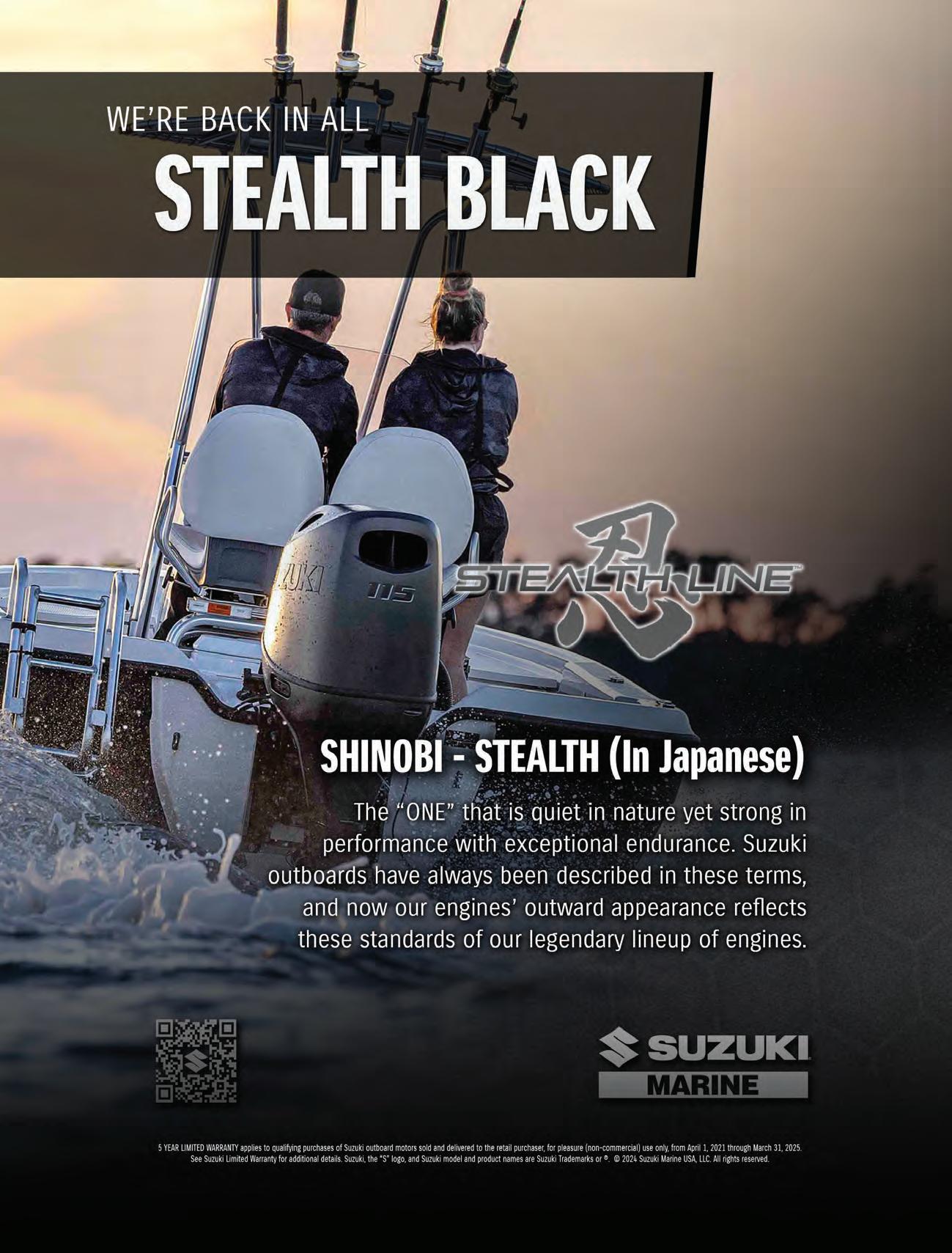
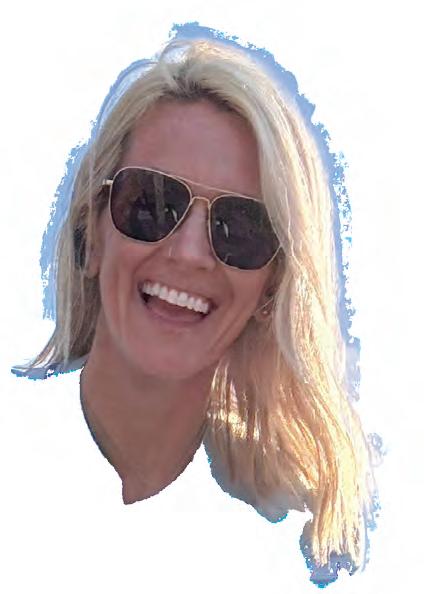













The new Carnage ™ III series rods are constructed from carbon or an e-glass and carbon blend, for an extremely powerful rod that leaves fsh begging. Yet it’s light enough to keep a fisherman going until the battle is won. Spec’d with high-end components like Fuji ® K-Guides, Sea-Guide ® and Fuji ® reel seats, plus a mix of hypalon/rubber shrink tube handles, the new Carnage III rod promises to be as ruthless as the name implies. PENN. LET THE BATTLE BEGIN ™ .
 ©2022 Pure Fishing, Inc.
©2022 Pure Fishing, Inc.
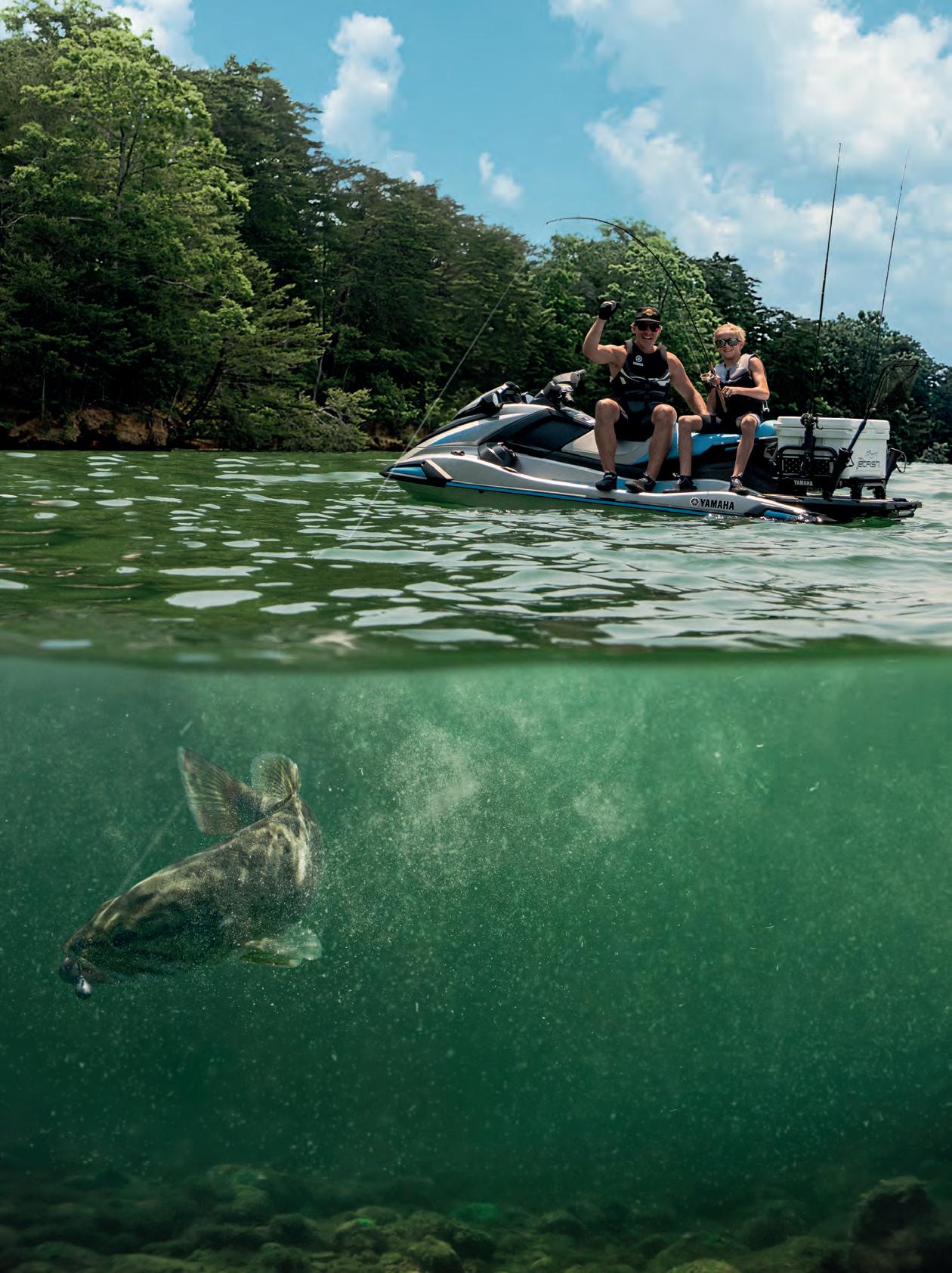
























Do you love boating? Then you know how fun and relaxing it can be on the open water. But you also know that things can go wrong sometimes, like storms, accidents, theft, or injuries. That’s why boat insurance is so important. Here are some reasons why.
• Boat insurance can help you pay for damage to your boat, or to other boats or docks, up to specifed limits.
• If you borrowed money to buy your boat, your lender may require insurance. And if you want to explore different places, some marinas or waterways may ask you to show proof of insurance.
• Boat insurance can also come in handy if you need an on-water tow, jump start, or fuel delivery with optional Sign & Glide® coverage. And if your boat sinks, boat insurance can pay for the cost of removing it from the water (if removal is legally required).
Get boat insurance from Progressive and enjoy the peace of mind that comes with it.
Scan to get a quote in as little as 4 minutes
Go to progressive.com to learn more.
If

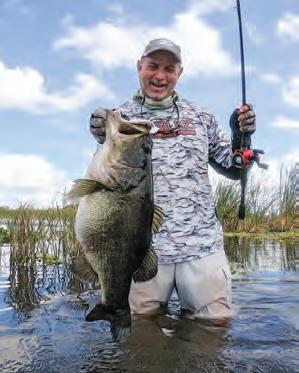


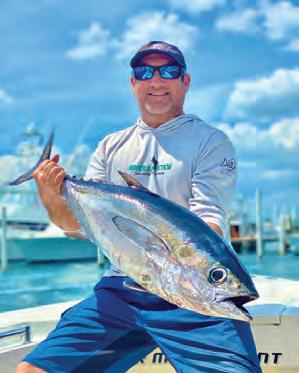

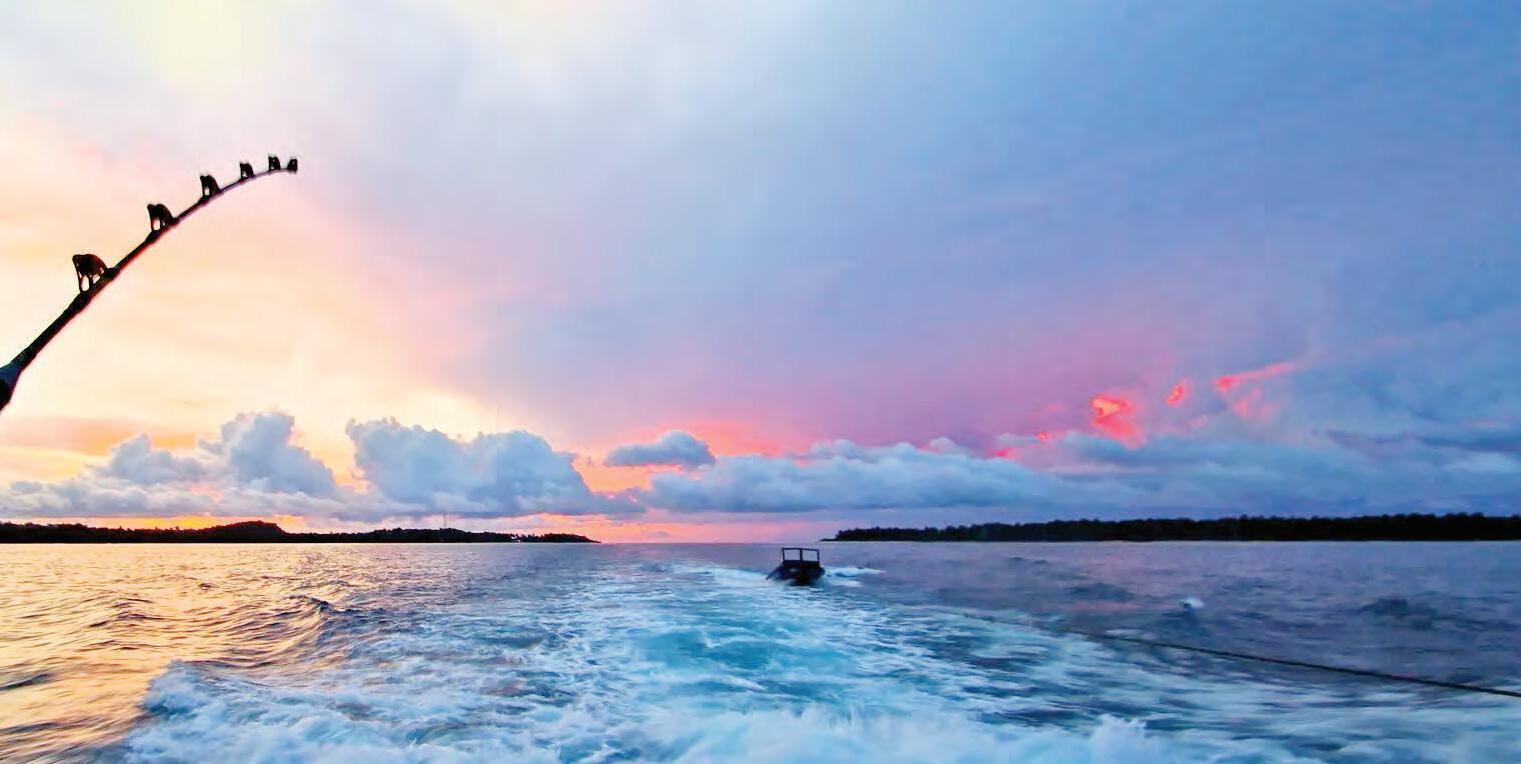




Introducing The All-New NavNet TZtouchXL Series
Transform Your Helm Into A Multi Function Masterpiece
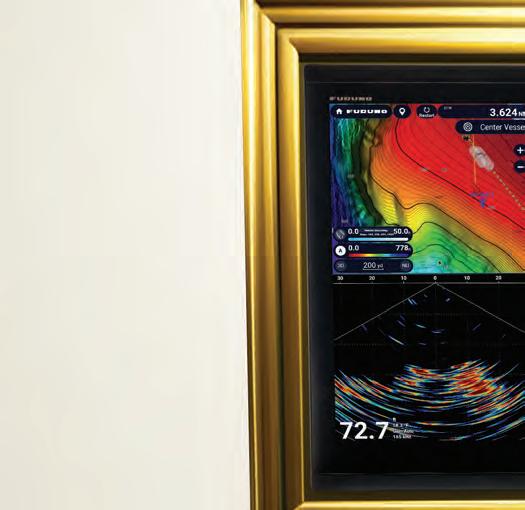
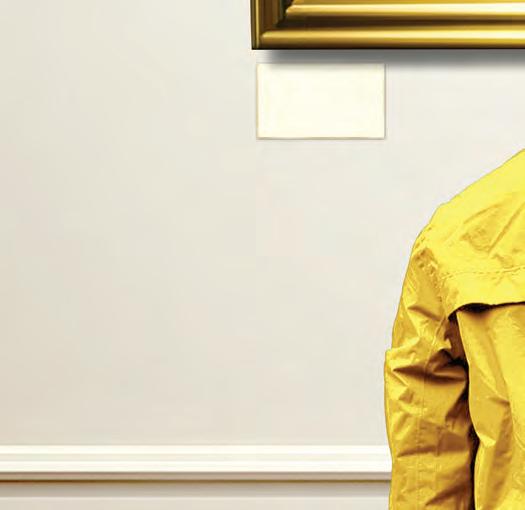


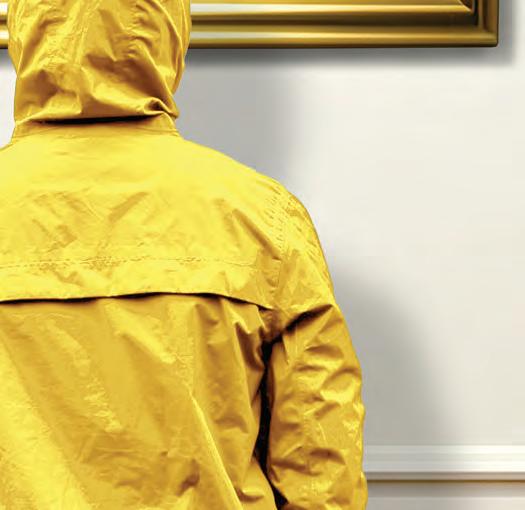
NavNet.com




Over the last few years, a burgeoning fshery has established the Gulf Stream out of Charleston as a big-time billfsh destination. Te ofshore trolling bite has been very good.
Capt. Mike Able keeps close tabs on the fshery. He and his brother, Graham, run Haddrell’s Point Tackle and Supply, a familyowned hunting and fshing store, which has grown to two locations and a fy shop in the Charleston area since their father, Mike Sr., started the business in 1983.


“Charleston has defnitely been put on the map with the billfshing we’ve had the last several years. It’s really been phenomenal,” Able said. “I mean, look at the Carolina Billfsh Classic. In the CBC last year there were outriggers full of sailfsh fags… we’re talking double-digit stuf. And not just the big boats. I mean, the big boats have an advantage, but guys are catching blue marlin from center consoles, too. You know the fsh are really chewing when the center-console guys are hitting fsh like that.”
Te Carolina Billfsh Classic (CBC) is one leg of the South Carolina Governor’s Cup Billfshing Series. It is held out of Mt. Pleasant each June. Last year, with poor weather
conditions during the one-day shootout, 47 boats released nine blue marlin and 53 sailfsh. Te top boat released four blue marlin. Te second-place boat released seven sailfsh and a blue marlin.
Able said conservation eforts, particularly from the Governor’s Cup, have led to healthier stocks. He also thinks anglers are getting better at fnding and catching billfsh. Te run outside the ledge is still 50 to 55 miles, but these days captains can go straight to potentially productive water. Satellite services make it easy to identify blue water, weed lines, temperature breaks and color changes to make a solid gameplan before leaving the docks. Additionally, technology like Omni Sonar can pinpoint fsh with an efective range of 5,000 feet.
“You could mark a fsh from a half mile away and go over and drop baits,” he said. “It doesn’t mean you can make them bite, but you know they’re in the area.”
Peak season for blue marlin and sailfsh is May and June, but blues will be in the area all summer. Sailfsh can be good into October or November, when wahoo enter the mix heavily. Able said a lot of marlin they catch are 150- to 200-pound “rats,” but they see some 300- to 400-pounders and an occasional 500-pluspound blue marlin. White marlin might also show up in a spread.
One of the perks of trolling out of Charleston in spring is you’ll also likely fll the box with dolphin and blackfin tuna. Capt. Able hung up his charter captain hat a few years back.
By Nick Carter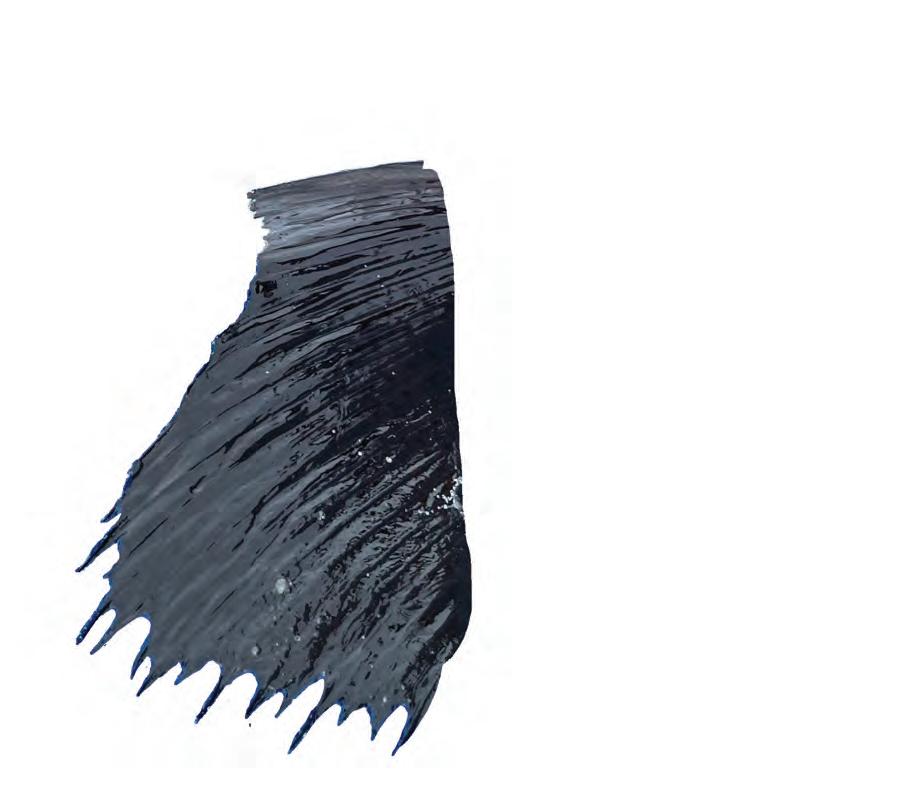
Now he fun-fshes with pretty remarkable success for billfsh and meat fsh by pulling a mixed spread with dredges, squid chains and circle-hooked ballyhoo from a ’34 Regulator.
Check out Haddrell’s Point Tackle & Supply at HadrellsPoint.com.
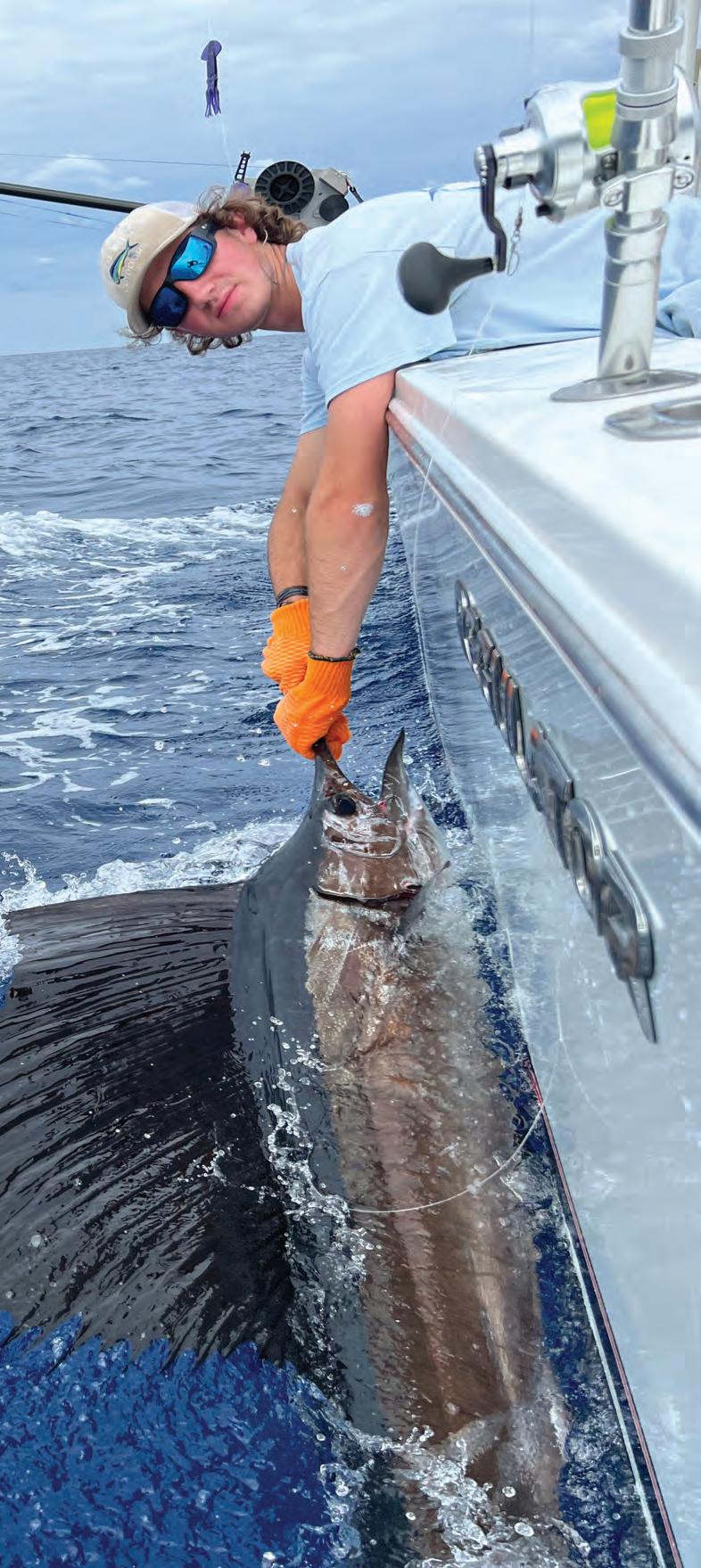

Instead of going “bottom fshing” this season, I would focus on going “grouper fshing”… at least for gags while the season lasts. You can go ‘bottom fshing” for the next seven months, but let’s put some gags in the boat while the law allows it! Here are some tips to help you bag some gags.
• Having the right bait is a major part of this puzzle. A pinfsh trap in a productive area for just a few hours and an (otter-proof) foating bait pen at the marina are priceless.
• You must anchor up or use the trolling motor in “spot lock” to properly fsh any piece of good bottom.
• When I frst post up on a good-looking mark on the recorder, I have everyone else on the boat fre down whole frozen squid on a jig. At the same time, I use a sabiki to catch whatever baitfsh are available on the structure. Here’s how it works:
1) Te squid might catch a handful “bottom fsh,” and maybe a grouper or two.
2) Most importantly, it sets a nice chum slick on the bottom that attracts the real predators of the structure directly under
your boat, and they will be ready to eat.
3) Afer four or fve volleys of squid, everyone baits up with a beautiful baseball-in-diameter-sized live bait and sends them back down to the bottom together. Tese baits are too big for most bottom fsh to get their mouths around.
4) Now, the grouper appear on the scene, curious about all the noise and the good smell. What do they see? Tey see a pinfsh from the marina or whatever came up on the sabiki. I like to fsh these baits on one of my Crab Decoy Jigs, which makes it look like the bait is struggling in the grasp of a hungry crab or squid. A big grouper, and especially a gag grouper, sees this as a Happy Meal. Tey love crabs, squid and baitfsh, and with this rig they think they’re getting it all in one bite.
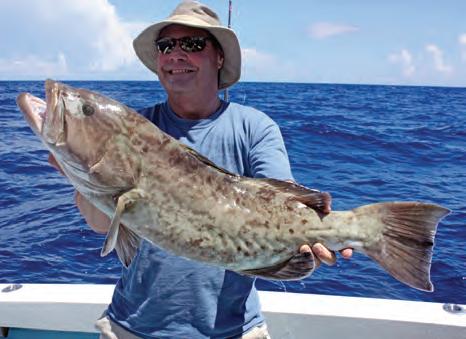
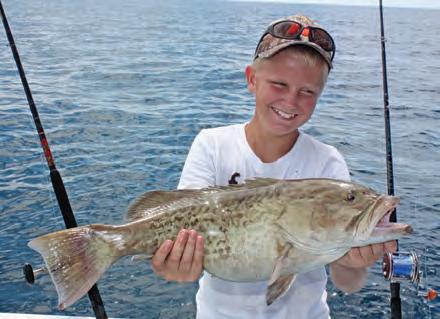
5) An added bonus is that this is clean tackle, free of excess hardware, that sends the correct signal to grouper and results in bites.
• Te downside to this style of fshing is it will attract sharks. It’s all fun and games until the man in the gray suit shows up. Ten it becomes hard work. Sharks of all kinds are drawn to struggling snapper.
For more info on the jig, tackle and/or bait, check out Tim Barefoot’s YouTube channel and website at barefootcatsandtackle.com.






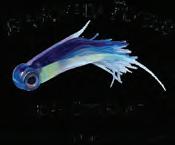
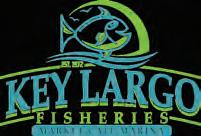



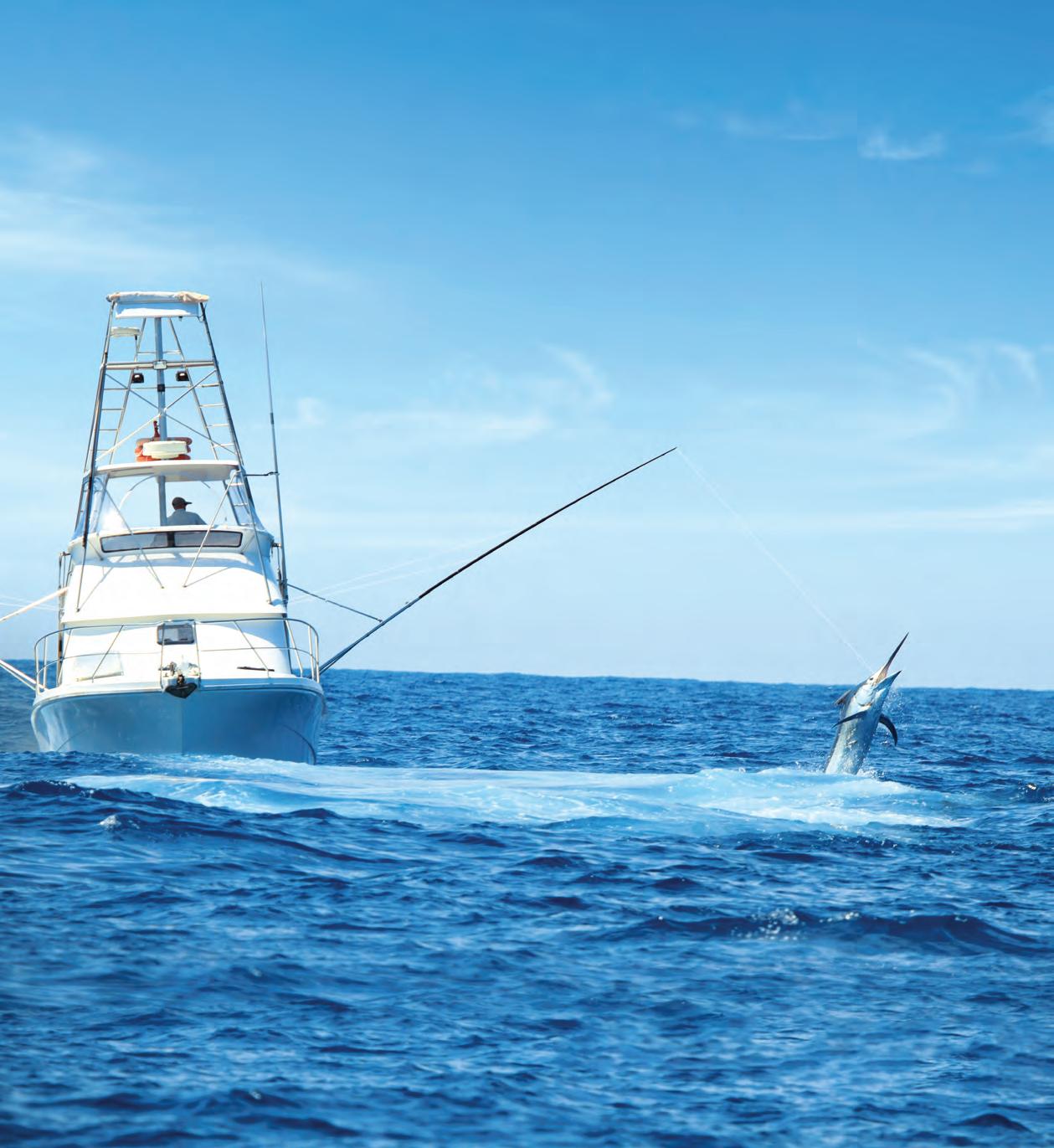

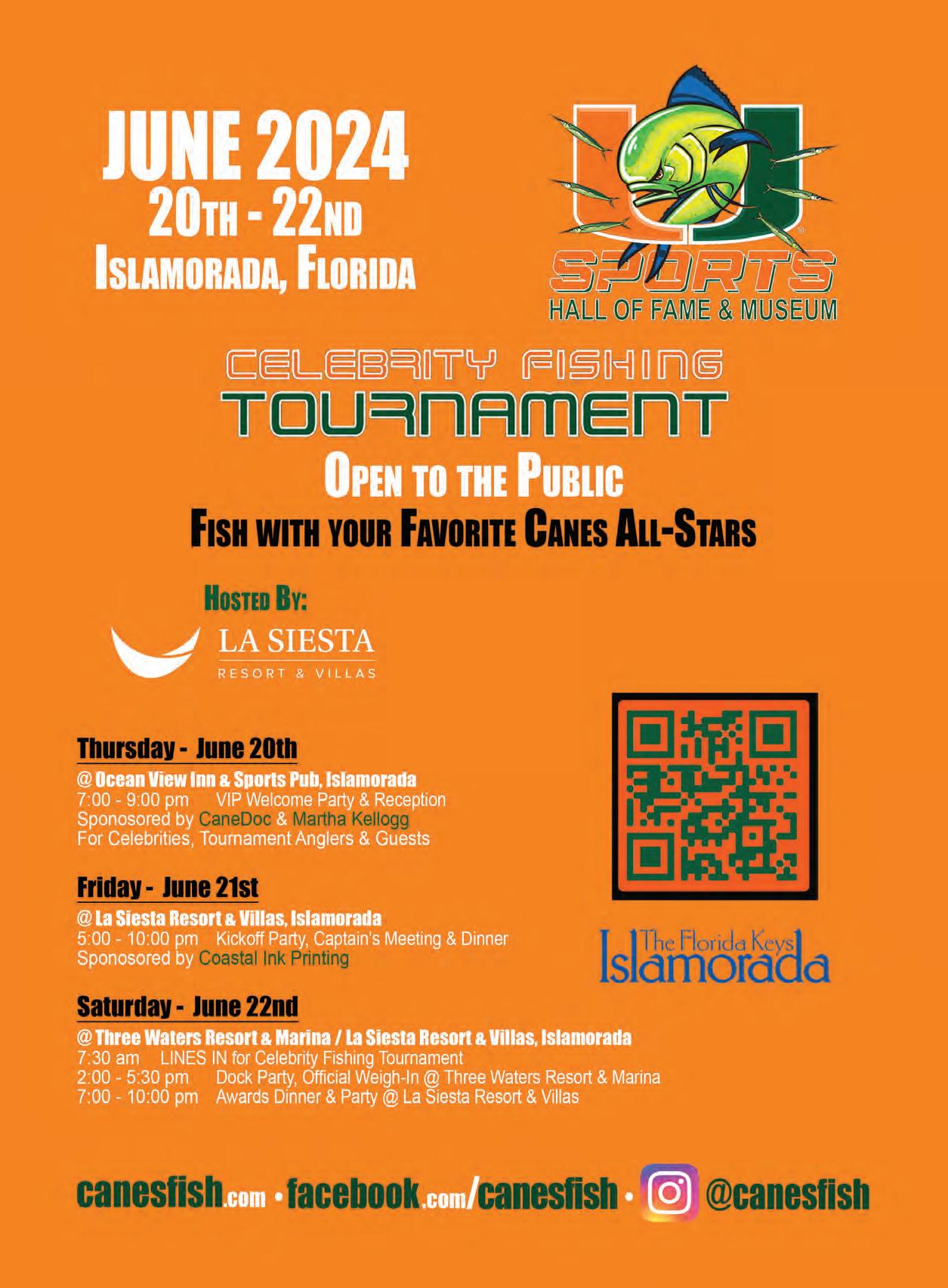
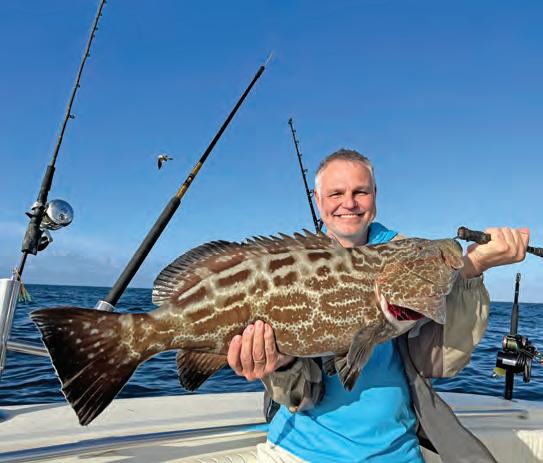 By Capt. Quinlyn Haddon
By Capt. Quinlyn Haddon
May 1 marks the reopening of Atlantic grouper season here in the Florida Keys. Over the past four months of season closure, a multitude of released catches taunted local fshermen, and now the hunt is ofcially back on!
While the Keys might not be well known for grouper, there is no reason why they shouldn’t be. Between the reef, wrecks and ofshore deep-dropping, the Keys are home to a plethora of grouper species. Te reopening of red, black, gag and snowy grouper vastly
increases fshing opportunities here in our Atlantic waters.
When fshing for grouper on the reef, keeping your rig from getting rockedup on the bottom is the biggest challenge. Do not overweight your rig, and keep an angler on or near the rod at all times. Grouper are notorious for grabbing a bait and taking it back into their homes immediately. When you lose a big grouper, especially with a mouthful of your tackle, they grunt a warning to the other fsh. Tis shuts down the grouper bite. It is best to keep the grouper rod in your hand when possible and be ready to crank them away from their hidey-holes. Tere isn’t much room or time for error on the initial bite.
Fishing for grouper over wrecks can also be highly productive. Amberjacks, which received a short closure in April, can be caught as bycatch while wreck fshing for grouper. Teir season also reopens in May.
Deep-dropping ofshore also expands greatly this month, as snowy grouper and blueline tilefsh reopen. Yellowedge grouper remains year-round, but even with large grouper hooks, tilefsh can be a frequent bycatch. Deep-drop rigs can be modifed this time of year to include smaller hooks that welcome the tilefsh bite and increase productivity of each drop.
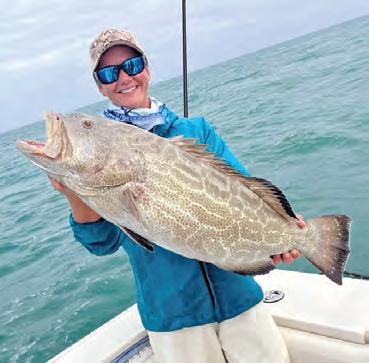
Te abundance of mahi-mahi this month sweetens the deal for heading shore to deep-drop. Not only can you fsh for mahi-mahi on the route to, from and on your deep-drop numbers, you can also chase birds for a chance to read the bottom for new deep-drop spots. Tere is nothing quite like fnding a new fshing spot, and with so much in season right now, it is the perfect time of year to scout.
Remember to check fshing regulations, as there are ofen surprise closures on many species. Venting and descending tools are required when fshing for grouper and are especially important at the depths where snowy grouper are found. One look at the bug-eyed balloon face of barotrauma will tell you these fsh cannot return home safely without help. It is easy to go over a limit of snowy grouper by accident, so have your gear ready and know how to use it.
Sweet E’nuf Charters specializes in grouper and is already booking up quickly for the much anticipated reopening. Give us a call to get tight!
Capt. Quinlyn Haddon guides with Sweet E’nuf Charters out of Marathon, Florida Keys. Contact her at (504) 920-6342 or Captainquinlyn.com.
Find her on social @captainquinlyn.



Julia Bernstein, 12, of Miami, had a record-setting day fshing of Key West on Jan. 5. She set two new state records in a day by catching a 20-pound, 15-ounce cobia and a 1-pound, 8-ounce mangrove snapper while fshing with Capt. Dale Bittner.
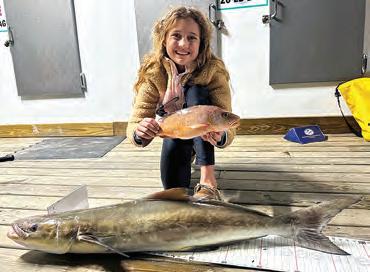
Bernstein’s records were the frst two fsh certifed in Florida’s new saltwater record categories, which were launched in January. Tey both set the bar in the new Youth All-Tackle Weight category. Florida is also now recognizing state records for Youth and Adult Length Categories.
“‘Are those all cobia?’ I couldn’t believe it, as we pulled up to the wreck, there was a dark cloud on the surface of the ocean. Sure enough, it was a large school of hungry cobia, and they were ready to eat!” Bernstein said. She quickly hooked up to two smaller fsh, but in her words, “Tird time was the charm; it was an even larger cobia! We had a great afernoon, we caught six fsh from that school, one of which became the Florida state record and one of which is a pending IGFA Junior Record.”
Bernstein already holds 11 IGFA world records.
To fnish the day, they made one last stop, where Bernstein hooked up with her record mango.
“I worked hard to get it of the bottom and then reeled as fast as I could. Good thing I did, turned out to be a state record mangrove snapper!” she said.
Joseph Ingold set the bar for the redfsh length state record with an impressive 36.25-inch red he caught from a Kayak in Panama City in February. His story is of a slow day that turned exciting in a hurry.
“About halfway down, I hadn’t gotten a single hit, so I cast my paddletail and let it sink to the bottom while I grabbed a new lure to tie on. Once I got my new lure ready, I started to reel in my paddletail to switch it out,” he said. “About fve seconds afer I started to reel it back in, the redfsh hit.”
Ingold thought he had snagged the bottom, but then the fsh began to run.
“I got super excited and loosened up my drag at that point. I really didn’t want to break her of since I was only using 10-pound test,” he said. “When I landed the fsh, I honestly didn’t even think about submitting it for the new length record. I actively participate in the Catch a Florida Memory programs, so I just took pictures for myself and for the Reel Big Fish program. Afer I submitted for a Reel Big Fish, I was curious if anyone had submitted for the new length record and, to my surprise, it was still vacant. So, I took all the pictures I had and put in my application.” CALL
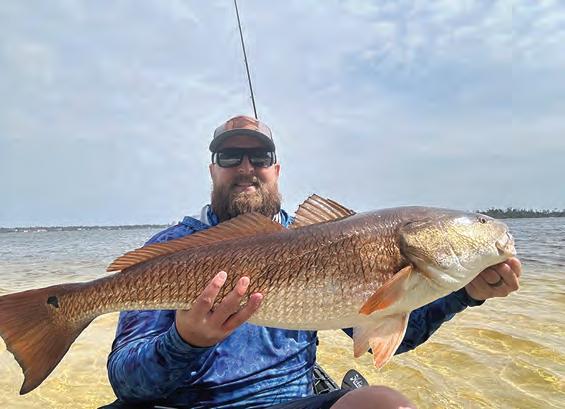
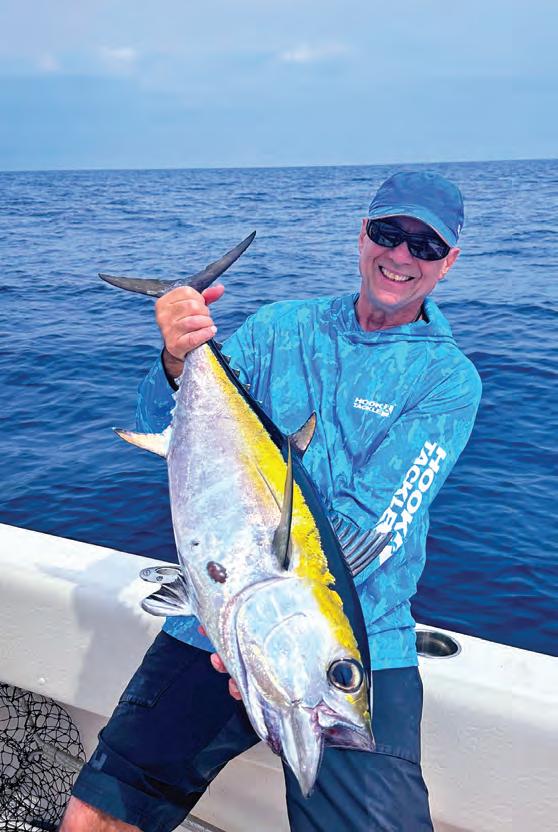 By Mark Ambert
By Mark Ambert
You know spring has ofcially arrived when the eastern seaboard welcomes the arrival of voracious blackfn tuna! What better way to shake of the winter doldrums than to get out and target these small but mighty speedsters.
May and June are great months to target these fsh. Tey enjoy a wide range from Cape Cod to South Florida, and during the summer they migrate to temperate waters that remain above 70 degrees. Tey inhabit the warmest waters of all tuna species.
Blackfns are a schooling fsh and feed on migratory baitfsh, squid and shrimp. Tey frequently hunt the deeper side of the ledges and reefs common to the eastern seaboard. Tey commonly range from 5 to 20 pounds, with the occasional 30-pounder blowing up your bait!
Live bait is best for bigger tuna. I prefer goggle eyes, which can be caught or bought. Due to their hardiness, they are worth the cost to have on hand.
For live baiting, I use a Shimano Baitrunner OC size 6000 reel spooled with FINS 40G Braid. With the diameter of 6-pound mono, this braid has a tensile breaking strength of 45 pounds. I pair this reel with the Shimano Terez model TZS69M, 6-foot, 9-inch medium action spinning rod. I use a 6-foot section of Seaguar fuorocarbon in the 30-pound range for leader and Owner SSW 6/0 or 7/0 cutting point hooks. Blackfn are leader shy, so start with a 30-pound leader and move up to 40 only if you are experiencing breakofs.
I combine live bait with jigging techniques when targeting tuna. For high-speed retrieval of lures through the water column, which these fsh prefer, I use the Penn Battle III 4000 HS (high-speed) spinning reel. I pair this with a 6-foot, 6-inch Shimano Trevala B. I start of using Rapala Williamson Kensaki jigs in the 120- to 220-gram range.
Pro tip: Switch sizes and colors until you fnd what best “matches the hatch” rather than switching jigs.
I fsh early mornings, as tuna can be both light and boat shy. During a full moon cycle, the bite can turn of quickly as the fsh have been feeding most of the night. Once on my target area, I set up for a drif just outside the frst reef system, past the drop-of in deeper water to avoid bonito, sharks and kingfsh. Tis is typically in the 225- to 300-foot range. I deploy two live baits—one in the bow and the other in the stern—then jig in the middle. Check your fshfnder ofen to identify “scratches,” or fsh moving through, and mark the depth they appear in the water column. Target these fsh while jigging.
Te food quality of blackfn depends on proper bleeding when they are frst caught. Make a small incision behind the pectoral fn on both sides of the fsh to ensure the highest quality meat. Catching these speedsters will quickly become an addiction, and now is the time to make it happen!
Find Mark Ambert on Instagram @marksgonefshing_™; email: marksgonefshing25@gmail.com.

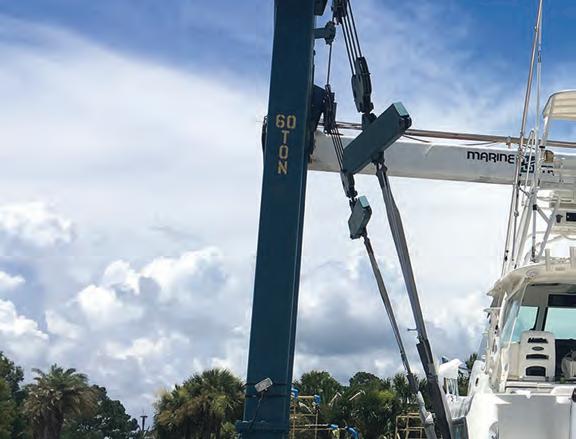









Whether considering repowering your trailer boat or your offshore beast, there is a Mastry Suzuki RePower Center that can serve your repower dreams. Mastry Suzuki RePower centers are the best in the business and have the experience, technical know-how and boating passion to make your repower project a remarkable success. With total boat systems capabilities your local Mastry Suzuki RePower Center can address all your upgrade aspirations. Essentially transforming your boat into a totally new boat at one single location.
With 15 Locations Across the Southeast There is a Mastry Suzuki RePower Center Near You.



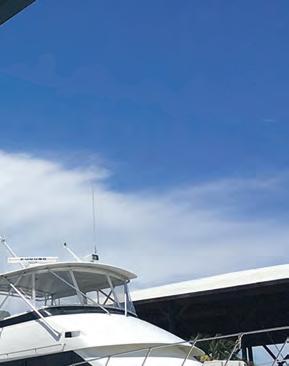








*Get with the Program!



When you purchase a new Suzuki outboard from an authorized Mastry RePower Center you qualify to become a member of the Mastry Suzuki Owner’s Edge. Owners receive an identification card that provides them with important information about their Suzuki outboard motor as well as a passport to additional benefits during ownership. Members enjoy a detailed engine maintenance schedule, Mastry Suzuki RePower Trade Program and special pricing from Mastry Suzuki Partners.




Durable boat lifts expertly designed with Florida in mind.
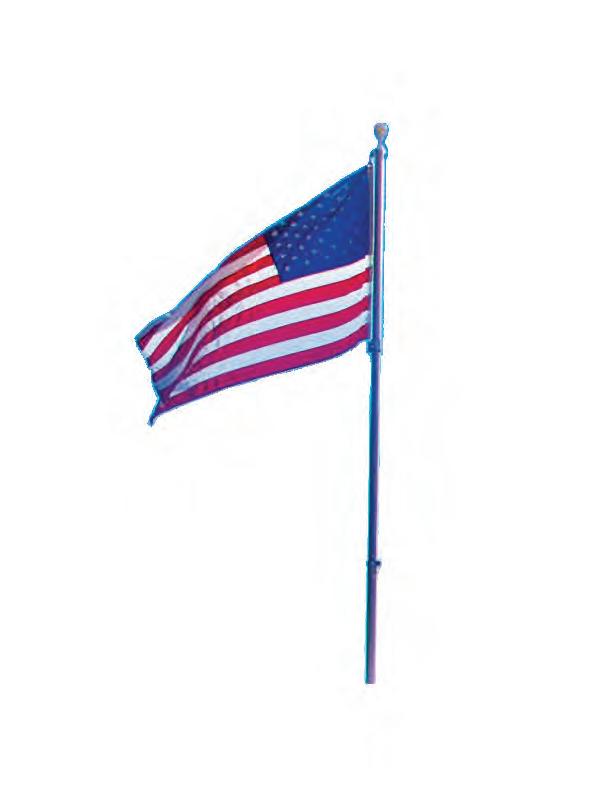
ShoreStation hydraulic boat lifts are a reliable choice for coastal residents and boating enthusiasts alike. Their strong construction, made with corrosion-resistant materials, allows them to withstand harsh environmental conditions, including sun, storms, and saltwater damage. ShoreStation provides a steadfast solution for protecting waterfront investments, ofering peace of mind to owners in the Sunshine State.



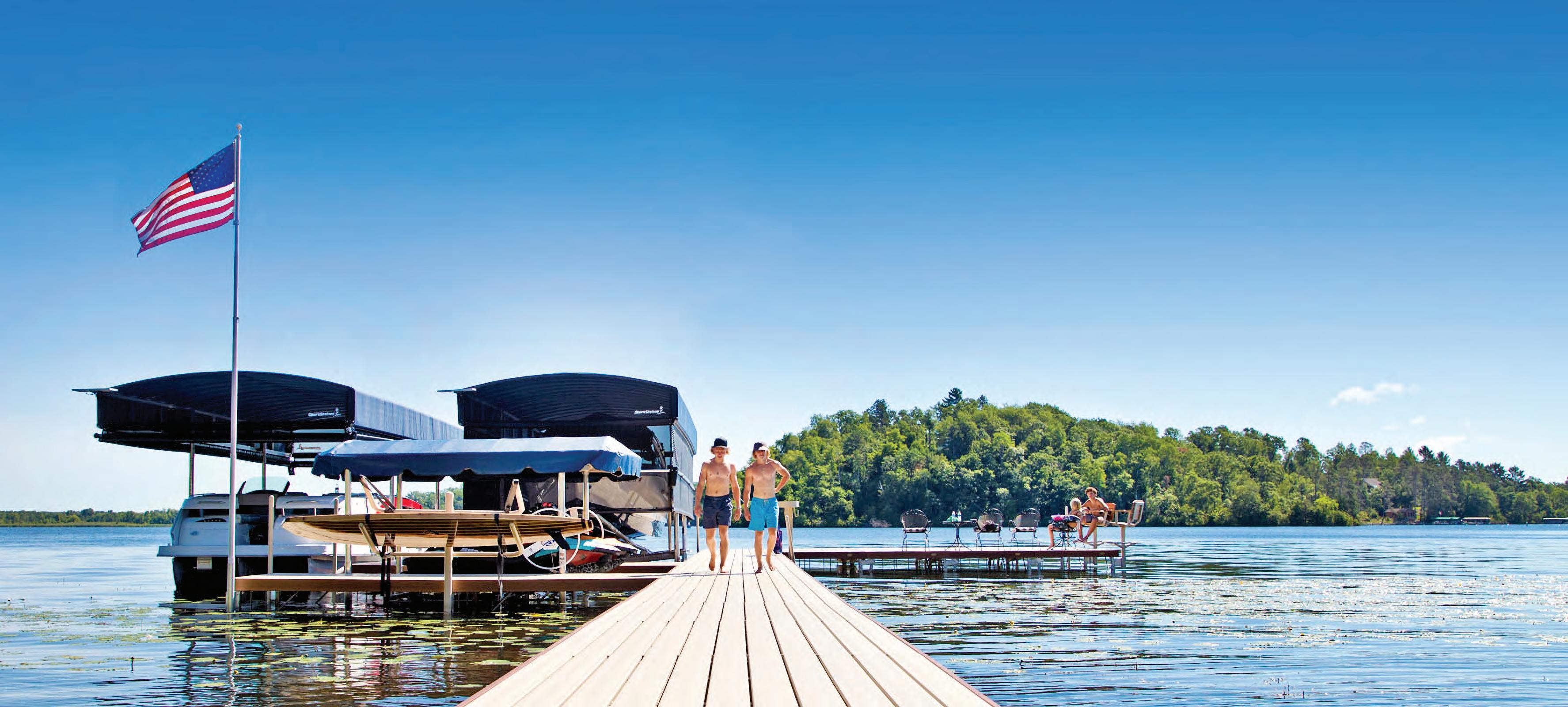


Equipped with exceptional weather resistant fabric and breathable SunTex 80 woven mesh ends for maximum protection and durability,

Made from the highest quality materials, our innovative hydraulic boat lift is one of the fastest and safest lifts on the market today. When you have a hydraulic lift, there’s no need to worry about wind and waves getting in your way. This lift will give you confdence to safely land and secure your boat in less-than-ideal conditions. No Piling Required
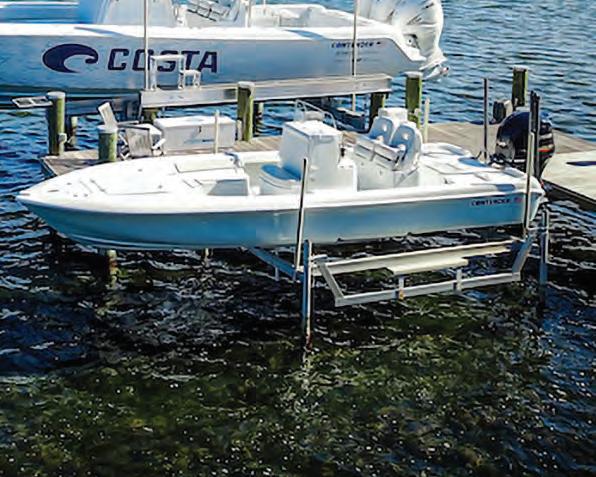
Never miss another moment on the water. Power your lift with clean, free solar power. Our speedy 20 watt charger features solar regulator drainage protection, saving your battery from permanent damage caused by overcharging.












On Solid Ground RV and Boat Storage is proud to bring premium boat storage to the Space Coast! We are conveniently located just minutes from the coast and Port Canaveral, perfect for storing your weekend water toys so when you’re ready, you’re right by the action.
Our state-of-the-art security system includes 24/7 surveillance cameras, electronic gated access, and on-site management to ensure your RV or boat is safe and secure at all times. Our top-tier amenities include on-site dump stations, water and electric hookups, and a wash bay for easy maintenance.
With over 270 spaces available, we have options to fit all sizes of RVs and boats. Whether you’re looking for a simple uncovered spot, a canopy covered space, or a fully enclosed unit, we have the perfect storage solution for you. Don’t wait, call us today to reserve your space and take the hassle out of storing your weekend water toys!






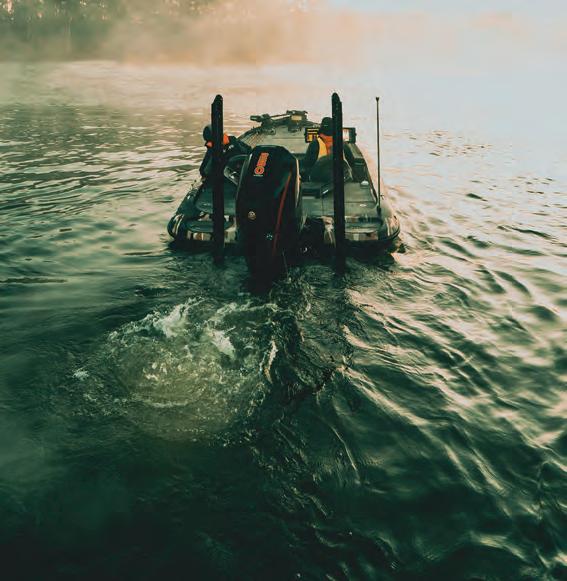
Hello fellow Anglers! Seminole Junior Anglers’ Bass Nation High School tournaments comes to an end. Our last tournament of the regular season was held the weekend of April 13-14 on Lake Toho in Kissimmee. It was a beautiful weekend with lots of fish caught and a top ten finish for the club. Saturday 4/13 Jordan Spitler and Aiden Greivell had the clubs’ best bag with 16.38 pounds finishing in the money at 9th place. This was very exciting; it was their first season as tournament anglers and their best finish ever. These boys have come a long way, and we are very proud of their growth and achievements. Sunday Brady Biles and Patrick Bartolotta lead the pack with 13.86 lbs. to finish off the weekend.
We do have a few seniors graduating high school and moving on to their next stage in life. James Cruz will be attending Methodist University to play baseball. Ben Bracket is going to The University of Florida. Carter Burdet will be attending Troy University and will be fishing the College Series on their team. Patrick Bartolotta has started his own landscaping business called Grass Roots Service out of the Lake Mary area.
As a club we are very proud of our teams and our performance this year and we look forward to the state championship in June on lake Seminole. Nathan Bennett and Carter Burdett also qualified for the national tournament and will be finishing Lake Chic in Tennessee in August.
Osceola Anglers High School fishing program is having their 10th Annual Fundraiser Bass Tournament on the Kissimmee Chain out of Joe Overstreet Ramp on May 11th, $10,000 to win, $25K in prize money, expecting 150 plus boats. $225 per team entry includes steak dinner at the weigh-in! Support our kids - our next generation of anglers and conservationists. Visit www.osceolaanglers.com for registration, $300 day of the event.
We could not do it without our sponsors; Coastal Angler Magazine, Avid Sportswear, Mudhole Custom Tackle, Accurate Fence, Grove Scientific and Engineering Co, Mullinax Ford, Dave’s Hot Chicken, Bitters Baits and Oakley.
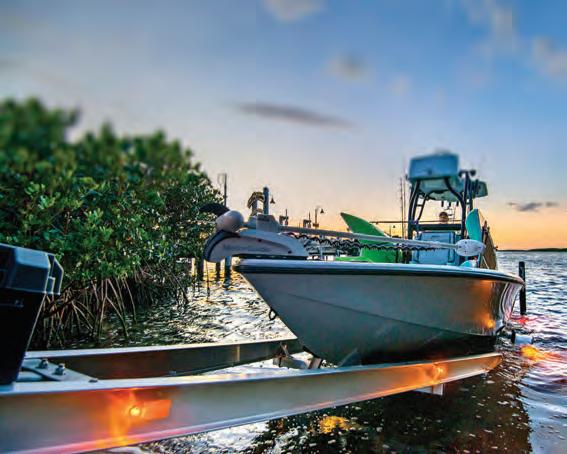

Thanks for reading. We hope to see you on the water! If you have a young angler, and they would like to fish with our club, please call Troy Bennett 321.303.0650 about joining us for next season.



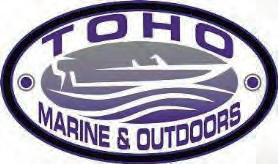
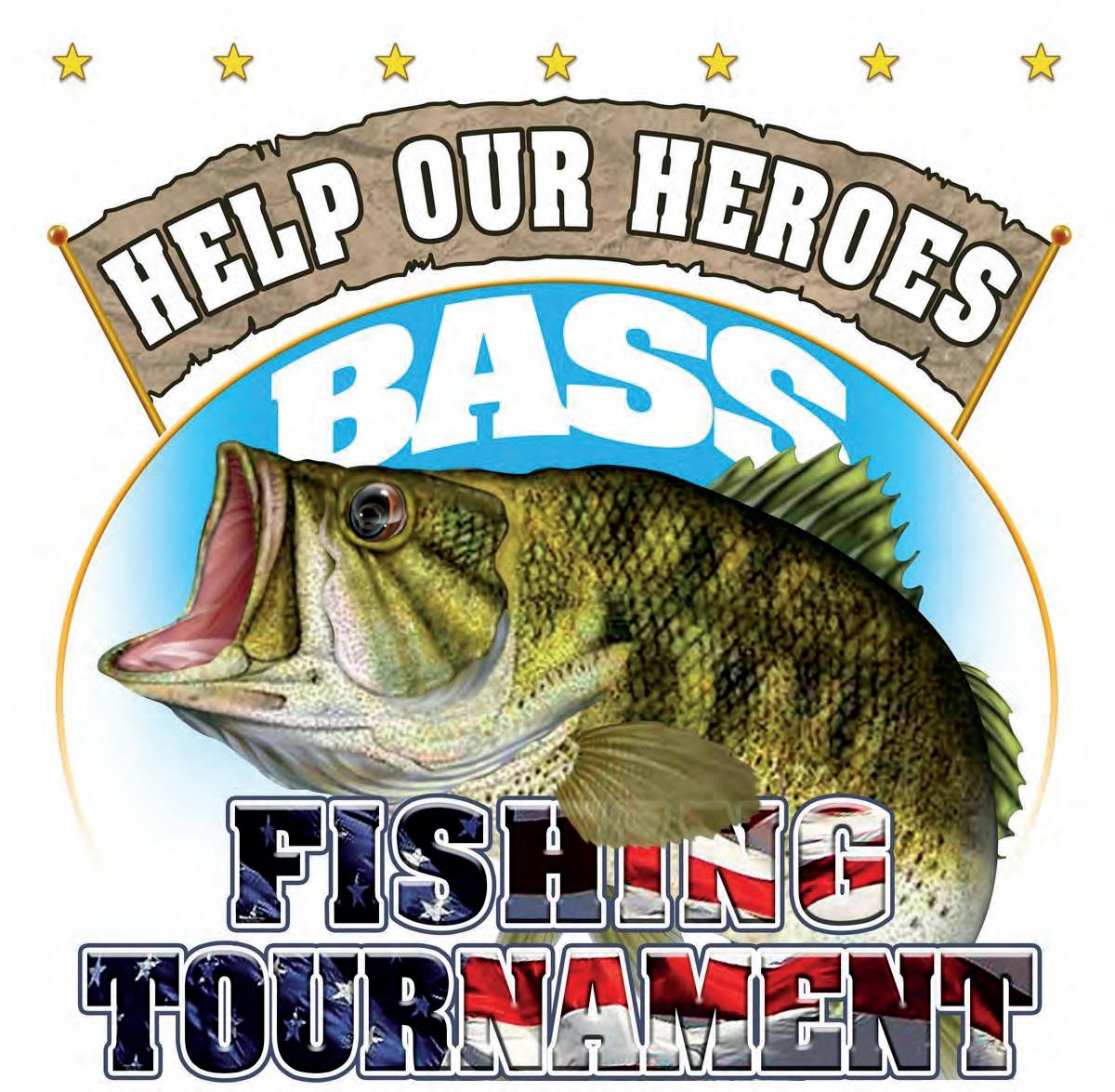




June 1, 2024 on the Kissimmee Chain of Lakes to benefit Local and National Wounded Veterans Groups.
June 3, 2023 on the K issimmee Chain of Lakes to benefit Local and National Wounded Veterans Groups.
$200.00 per boat (includes Big Bass). Launching out of Camp Mack in Lakes Wales. Tournament starts at safe light, 3pm weigh in.
$200.00 per boat (includes Big Bass). Launching out of Joe Overstreet Boat Ramp on Lake Kissimmee. Tournament starts at safe light, 3pm weigh in.
Registrations will be accepted until May 26.
Registrations will be accepted until May 18th.


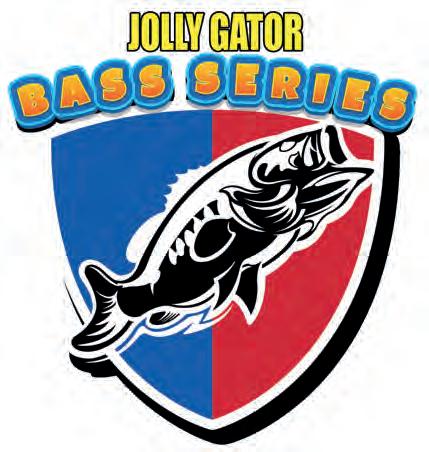
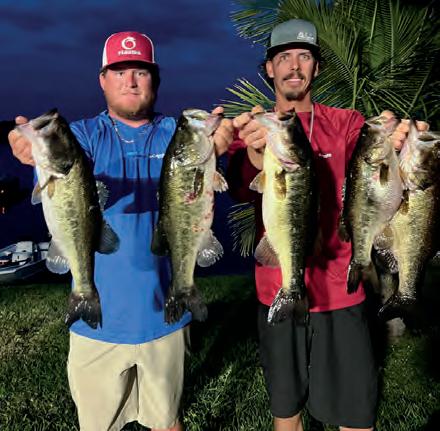
PRESENTING SPONSOR: this decent limit of 16 lbs. May
Saturday 4th, Tuesday 7th, Tuesday 14th, Tuesday 21st, Tuesday 28th June
Tuesday 4th, Tuesday 11th, Saturday 15th, Tuesday 18th, Tuesday 25th July
Tuesday 2nd, Tuesday 9th, Saturday 13th, Tuesday 16th, Tuesday 23rd, Tuesday 30th
Tuesday 6th, CLASSIC Saturday 10th All Saturday events “Safe Daylight till 2pm”
ASSOCIATE SPONSOR:















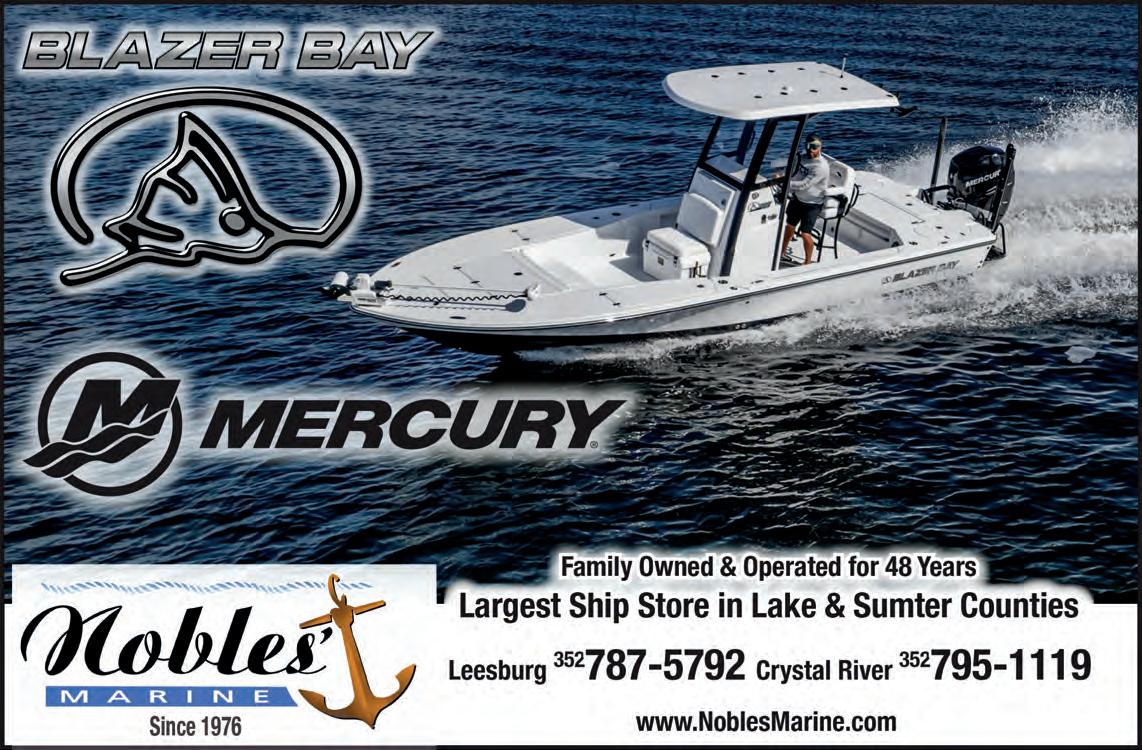

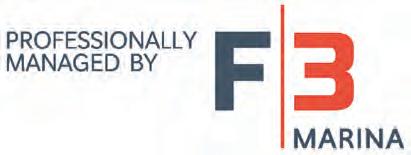

Fish from Bay Boats or Airboat. We also offer airboat tours on the coast! On our extremely scenic tours guests will have the opportunity to see many different kinds of wildlife like Manatees and Dolphins!
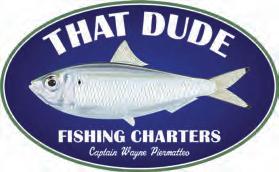



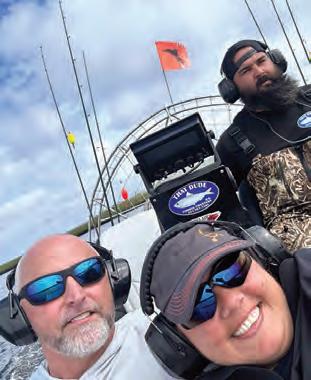
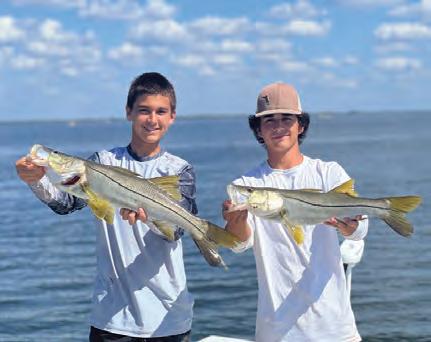
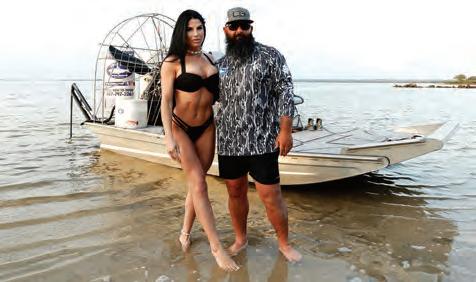


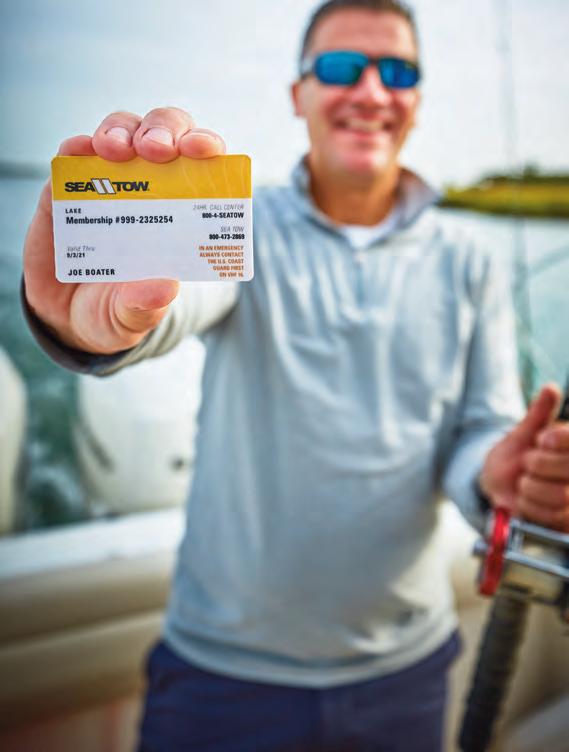



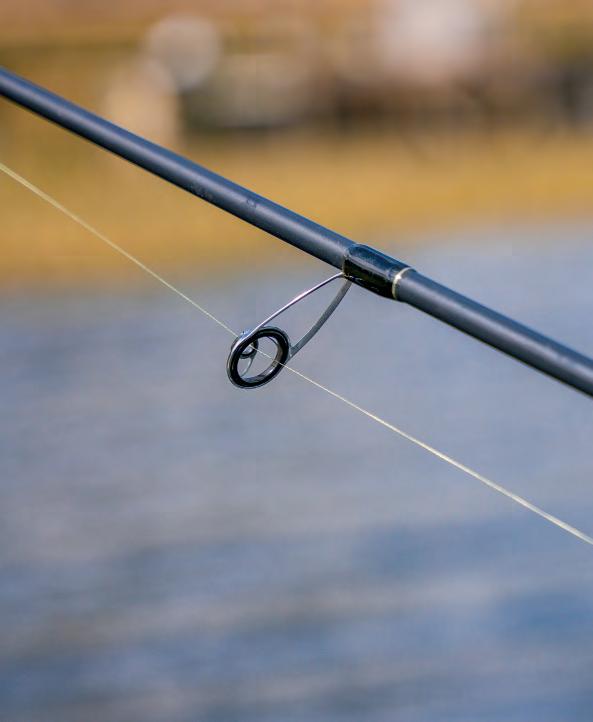

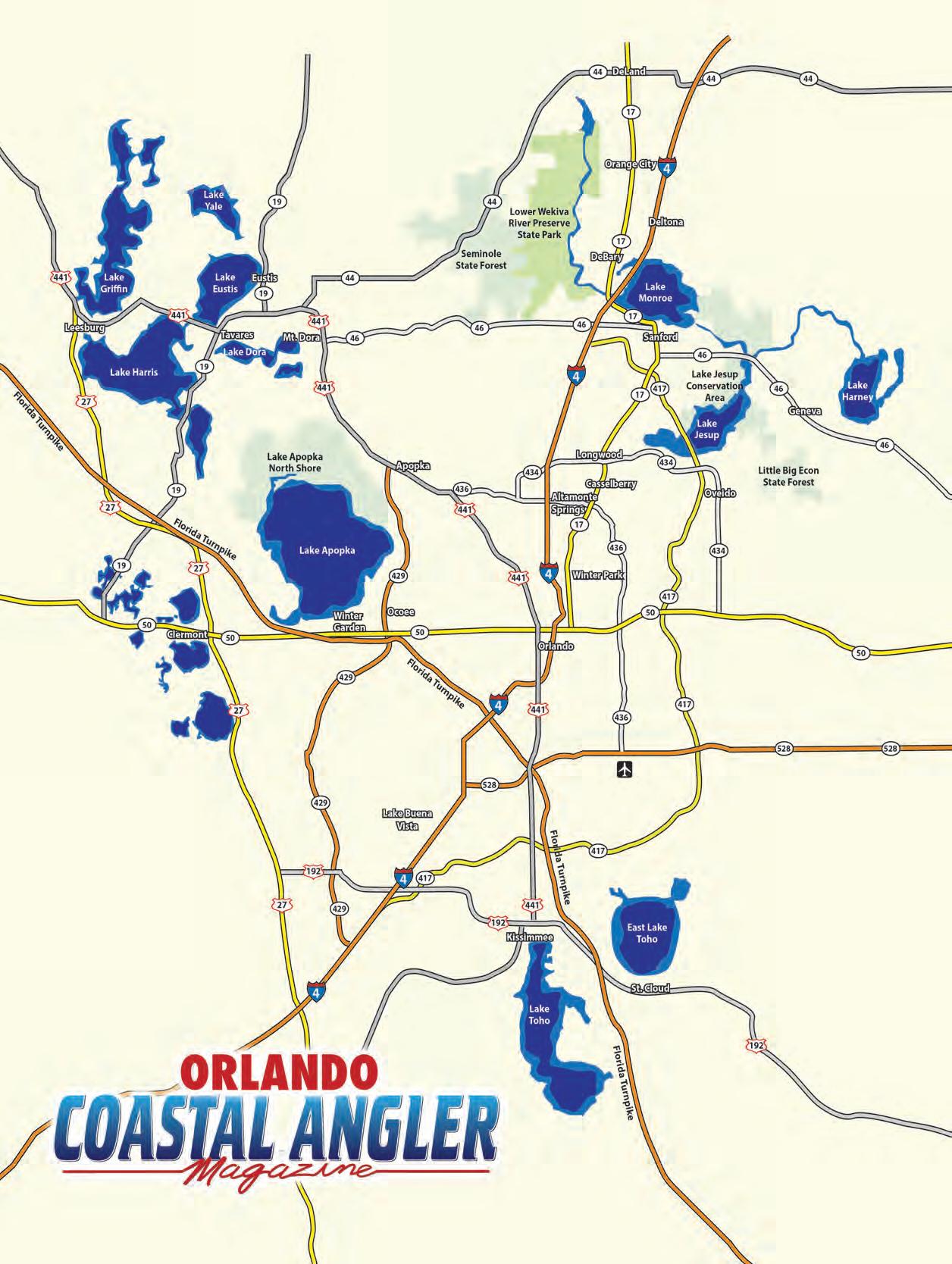
Sea Tow of Central Florida Lakes
(877)800-1492
12307 Wedgefield Drive , Grand Island, FL 32735
Always Looking for Captains
Lake, Orange, Western Volusia, Seminole, Osceola, Western Brevard, Eastern Sumter, Eastern Polk
All American Marine
7024 S Orange Ave, Orlando, FL 32809
Phone: (407) 855-9988

www.allamericanmarineorlando.com
Service All Outboard Brands – Stern Drives –Canvas – Interiors – Trailer Repair
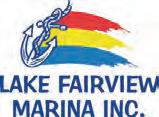
Lake Fairview Marina
4503 N Orange Blossom Trail, Orlando, FL 32804
Phone: (407) 295-0117
www. Lakefairviewmarina.com
Consignment Sales – Outboard Service –Storage – Ship Store – Sailing Classes


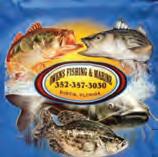
Saltwater

Triangle Marine 11415 US-441, Tavares, FL 32778
Phone:(352) 343-6146
www.trianglemarinecenter.biz
Bennington Pontoons – TideWater Johnson – Evinrude – Yamaha
Boat Max USA
9700 E. Colonial Drive, Orlando FL 32817
Phone: (321) 866-0306
www.boatmaxusa.com
Pioneer - Glasstream - Aquasport - Stottcraft New Boats Sales - Authorized Yamaha and Suzuki Dealer Parts and Service

Thomas Lumber Company 231 W Gore St, Orlando, FL 32806,
Phone: (407) 841-1250
www.thomaslumber.com
Old Fashion Lumber Yard – Lumber – Trim –Custom Doors – Hardware – Delivery –Customer Service


Campbell Renovations Inc. 285 Campbell Ranch Run, Geneva, FL 32732
Phone:(407) 349-0016 Cell: 407-947-5460
www.campbellrenovationsinc.com
State Certified Contractor CBC 1255779
Residential

Vapor and Company
3621 S. Orlando Dr. Sanford FL 32773
Phone:(407) 878-7397
www.vaporandco.com
Electronic Cigarettes and E-Liquid Experts in Smoking Cessation Orlando Coastal Angler Magazine Approved! Altamonte Springs, Orlando East SR 50


seed, black and blue.


Summer is creeping up fast. The water tables are steadily dropping down to low pool for the summer rains and hurricane season. The hydrilla is topped out at the surface and the edges are well defined. Largemouth bass are moving to the current and staging at the canal openings, fish the moving water. At first light, fish open water hydrilla patches for the first hour. They are feeding on the schools of shad. Bait of choice are crank baits, X Raps, Rattle Traps. A lot of the bass are heading out to the open water hydrilla patches and will stay there all summer. The bait of choice in open water vegetation are plastic baits like the Zoom Speed Worm. Flukes are the hot baits this month. Colors are June bug, watermelon
Crappie are out in the open water. Be sure to fish the open water around the fish attractors. Troll at various depts until you get a bite. Use jigs with various colors, tipped with a minnow. The bluegill have moved up into shallow water to compete for spawning areas. This is the best time to locate the spawning locations - the males are aggressive and are starting to fan the beds and will be easy to see. The shell cracker will also be mixed in the same area. They are finishing up their spawn and will be in a little deeper water. Both panfish prefer the same type of spawning grounds but will move out deeper due to warming water temps. This is one of my favorite times of year to catch them on the fly rod with a popping bug. Another good bait to use is a Beetle Spin in any color. If you are a live bait fisherman, crickets under a float is the best bet in the Kissimmee Chain!
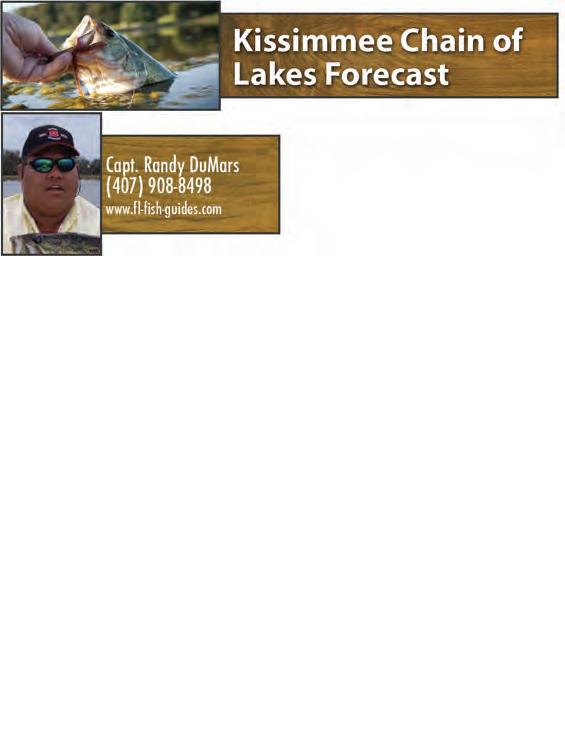
popping bug. I have thoroughly enjoyed hearing the popping bug get hit. Daytime anglers are catching good numbers fishing the shallow bedding areas. Bait of choice is crickets fished under a float.Another good area to fish is canals when the water is flowing, trolling will only trigger more bites. Crappie - Anglers are fishing open water for crappie using jigs tipped Anglers trolling jigs are catching good limits of crappie. The key is to find them

Bass and crappie fishing has been on fire with record number big bass, quantity of bass and crappie limits being caught despite the spawn coming to a close until sometime next November. The bluegill is spawning now, and the month of May is a great time to fish for them. Typically, when fishing for bream, my customers will use a 7 ft ultra-light spinning rig, with 4 lb. mono line, small split shot weight and bobber tipped with either a cricket or red wriggler worm. Fishing for bream provides a lot of fun, fast action and great tug on the line which is great for the little anglers. If you haven’t had the chance to fish the big O for our two-handed size bluegill now is the time to call and book your trip. I can accommodate 3 people when bream fishing.
Areas to try when bass and bream fishing have been some areas on the Shoal; Monkey box and Dupree bar; around Dyess ditch; parts of Horse Island; North end of Tin House; 2nd point; parts of Kings bar and Grassy. If you are fishing the east side, try
areas around Nub N Slough; Hendry Creek and around J & S back in.
Bass lures to consider: worms; swim baits/swim jigs; shallow jerk baits (hard/soft); top water; flipping/pitching (isolated cover); shallow crank baits. Color schemes are shad; bluegill; crawdad and tilapia and live crickets/worms when pan fishing. If you’re launching at the Indian Praire boat ramp use extra caution when loading/unloading your boat, there is no place to safely to get in/out of your boat. I am hopeful that Glades County will step up and fix the ramp? The other three boat ramps used on the west/north sides are in great shape, which is Harney Pond canal located in Lakeport; Scott Driver Park and the old Okeetantie campground, which will soon undergo a major change to a Bass Pro Campground and Resort. To book your next exciting and fun day fishing Okeechobee call 863-228-7263 or log onto www. southfloridabassfishing.com where you can find more trip information, customer reviews, pics, rates and etc. A big thank you to my sponsors: Toho Marine; Mercury; BnM Poles; Real Magic; Lews; Bullet Weights; Gene Larew; Pradco Brands; MidSouth Tackle; Maui Jim; Gill and Rapala.
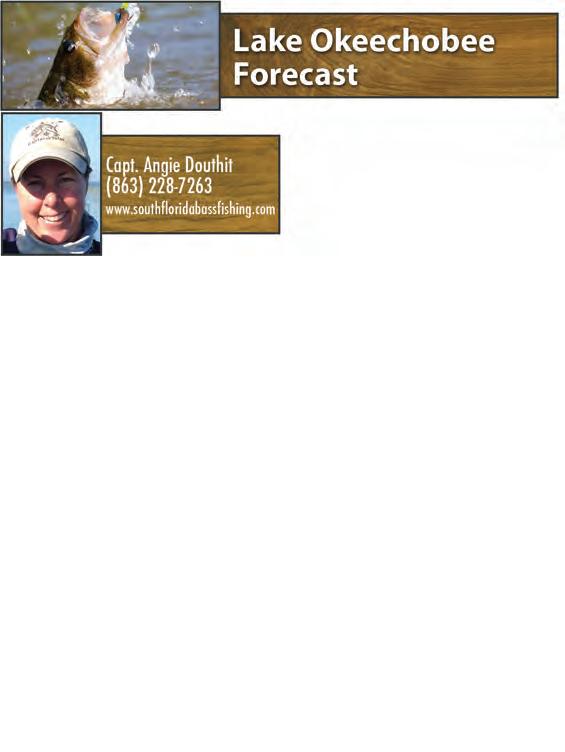

at nighttime in the canals using a fly rod, throwing popping bugs up against the bank. On a good moon phase, the bluegill will crush the
East Lake Toho - Bass fishing on East Lake has been good using artificial baits early morning. The best place to fish will be at the edges of the cattails. Then move to open water as the morning progresses. Most anglers are flipping open water pepper grass matts with good success. Fish the deeper edges of the grasswatermelon seed, Junebug, and
Panfish - Fish open water shell beds with red wigglers. If you are looking to fill the cooler for dinner, the open water shell beds are hard to beat.
bass trips which are typical for this time of year. The month of September is when to start thinking of booking your bass fishing trip, as the females start to feed up while they make their way into the shallows for the early spawn time. It’s also the time to book your fall crappie trip too. Good fishing areas: parts of the shoal; Dupree Bar; Dyess ditch and Horse Island and Indian Prairie. Tin house has been solid throughout the season for crappie, bass and bream, work your way up towards 3rd and 2nd point where you’ll find some bass feeding on the bedding bream. A few areas on Kings Bar have been good and
To book you’re next fun-filled, productive and educational fishing trip call me at 863-228-7263 or log onto my website to check out the customers and their catches; hotel recommendations; guide rates and etc. Capt Angie’s sponsors are: Caymas boats and Toho Marine; Lews; G-Loomis; BnM Poles; MidSouth Tackle; Maui Jim; Gill; Bullet Weights; Road Runner; Real Magic; Tru Turn hooks; Mega Strike; Gene Larew; Pradco Brands and BUFF


When spring transitions into summer our warm weather tactics and species come squarely into view. The smaller lures and baits like shrimp that are so productive inshore during our cooler months give way to big noisy topwater plugs and fullsize live baits like mullet and croakers. The warm water will have predator fish fired up and ready to chow down. Several of our favorite species that are hard to find, or flat not here in the winter months become readily available targets until the cool north winds blow again. None of these species piques more interest from my clients and myself than the honorable tarpon. Big or small I have yet to find a tarpon I didn’t enjoy tangling with, and there is good reason that they grace the top of many anglers’ bucket list. Many are shocked to find this majestic fish can be found in most of our islands canals as a juvenile has remained unchanged for eons. How nice of them to hang around even after they watched the dinosaurs come and go, so that we can get the opportunity to enjoy their hard pulling and frantic leaping fights. Not only does this fish have a long history, but they also have some pretty cool traits separating them from the vast majority of their finned neighbors. Most notably is their ability to process breathable (our) air as well as dissolved oxygen (DO) from the water. This leads to a very cool trick where they will “roll” on the surface grabbing a gulp of air. They will then process the air in a modified swim bladder and burp it back out. This gives them the ability to survive in areas with super low oxygen levels. Arguably this is the reason that tarpon has been so prolific for such a long time. The tarpon has very low-quality meat, so it isn’t considered a food fish and has been strictly catch and release with the exception of permitted tags for world record purposes. This is purely a game fish that gives one of the best fights around that leads to the addiction known as tarpon fishing. The canals and backwater swamps of Merritt Island offer a spectacular habitat that makes us one of the premier places in Florida to target the sub 50-pound juveniles. Still to this day the road I grew up on (Pine Island Road, Merrit Island) and the conservation area at the end of it is a great place to encounter them. No doubt those early years have helped cultivate my obsession with them. Being a warm water species and growing to 200 pounds, leads the larger versions to live a different life than the juveniles. Those fish migrate great distances throughout the year from the Caribbean in the summer to the Carolinas and even father north on the east coast. We get to experience a summer full of chasing this big version off our Central Florida beaches around the prevalent bait pods found in the surf zone. There is certainly no reason us islanders shouldn’t indulge in the availability of such a sought-after unique species.

Saturday May 4 - Safe light until 2pm, Jolly Gator Bass Tournament Saturday Series. Tournaments – every Tuesday evening plus one Saturday per month until the Classic in August. Entry is $50 to register team, $50 per event, 2 anglers per team. There is also a $20 side-pot for big bag. Saturday events (1 per month) are safe light until 2pm. Launch ramp is CS Lee Park next to Jolly Gator Fish Camp on SR 46 east of Sanford at St. Johns River Bridge. For more info contact Jim “Squirt” Chaudoin at 407-432-2822 or Phil Wolf with Coastal Angler Magazine 407-790-9515.
Tuesday May 7, 14, 21, 28 - 5pm until dusk, Jolly Gator Bass Tournament Series. Teams that finish in the Top 13 in points or win an event and fish at least 21 events will qualify for the end of year Classic. Some of the best river anglers in the area fish this bass series. Orlando Coastal Angler Magazine staff are the official weighmasters for this fun tournament series. Come out and join us for the weekly weigh-ins. All Tuesday events start at 5pm till dusk, Saturday events (1 per month) are safe light till 2pm. Launch ramp is CS Lee Park next to Jolly Gator Fish Camp on SR 46 east of Sanford at St. Johns River Bridge. Contact Jim “Squirt” Chaudoin at 407-4322822 or Phil Wolf Coastal Angler Magazine at 407790-9515.
Saturday May 11Osceola Anglers 10th

Annual Fundraiser Bass Tournament, Hosted at Joe Overstreet Ramp off Canoe Creek Rd., Kenansville. Safe daylight till 2pm, pre-register at www.osceolaanglers. com entry fee $225 per 2 angler team,($300 day of event) $10,000 to win, $2000 for big bass, steak dinner included, over $25,000 in total payouts, 150 plus boats expected… Come join us for a great day of fishing and see some giant bags of bass - help these young anglers’ club and raise funds for their college scholarship fund!
Saturday June 1st“Help our Heroes” Bass Tournament safe light until 3pm, to be hosted at Camp Mack located in Lake Wales on Lake Kissimmee Chain of lakes. $200 entry fee, registration closes on Saturday May 18th, no registration accepted on day of the event. $10,000 to win based on 150 boats, BBQ dinner included at weigh-in. To register visit www. tohomarine.com click on tournament tab or call them 407-892-3200. Come join us for this wonderful fundraiser, all proceeds go to veteran charities and wounded warrior projects!
If you have an event or meeting you would like included in the “What’s Hitting Around Town” column, send your details to: Phil Wolf phillip@ coastalanglermagazine. com. Deadline for inclusion is the 10th of the preceding month.

Look for post spawn largemouth bass lurking in the drop off next to sandy bottom – they are feeding heavily after they come off the beds. Target bass with big swim baits, top water ‘walk the dog’ lures, crankbaits, and rattling crankbaits. Early morning fishing and late evenings will become important toward the end of the month as the water temperature warms up. Best baits: live wild shiners, Rattle Traps (black/chrome), Heddon Spook Jr. (bone color), 4-and-5 inch swim baits in the color you are most confident with. May signals the panfish spawn – they will be bedding just about anywhere you find shell and or sand bottom in 1-4 feet of water, look where there is not
that much flow/current. This is a great fishery for youth anglers – take a kid fishing! Red worms and crickets will be the bait of choice. Grab your cane pole, and/or ultralight fishing gear and have some fun. The best areas will smell ‘fishy’ –the odor will tell you where to set the anchor and catch fish. Catfish will be found in the deeper holes and will bite like crazy a day or two following a heavy rain. They will be looking to fatten up for their spawn and will congregate in the river bends where it’s deep and the water is moving. Best baits: Fresh dead peeled shrimp works great, red worms and nightcrawlers, and small shiners from the bait store too. Bowfishing for tilapia along the shallow banks of Jessup, Monroe, and Harney will yield plenty for those equipped. It is easy to add a fishing kit to your hunting bow if you have yet to try it.
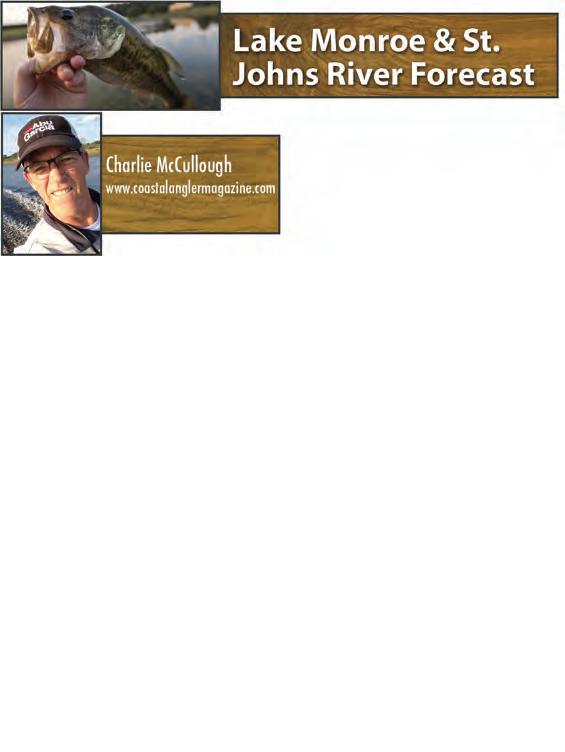
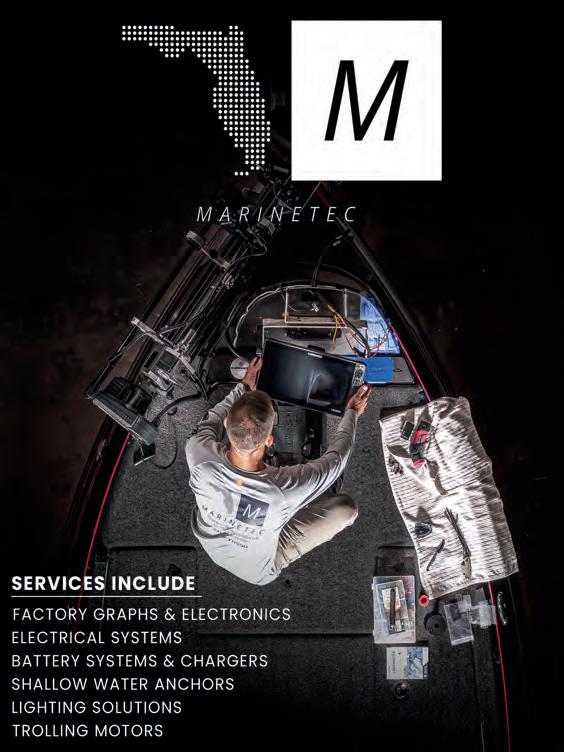

When it comes to pan fishing, this is the time to grab your gear and head for the Harris Chain. Bluegills and shellcrackers are both spawning along the banks in 1-4 feet of water. The big ones are out eating grass shrimp and worms. Hot spots like Dead River, and Haines Creek with the abundance of lily pads are the ideal locations to focus on. It is the perfect way to get a kid involved with fishing. Grab any rod, small hook, split shot, and a container of worms and you are set. Use light line, like 6- or 8-pound test clear monofilament. This should help get more panfish bites, and the big smart ones don’t see the line. If you’re lucky and get a big catfish, the 8-pound test will hold just fine.
The bass are done spawning and love fatting up on the panfish before heading to the deeper water for the summertime. The bass will
be in deeper water with eel grass, hydrilla clumps or areas with some bottom transitions but not too far away from the spawning pan-fish. The best baits for the largemouth bass are swim jigs, bladed jigs and also different varieties of large soft plastic swim baits. Any natural color like orange-perch, green pumpkin, black-blue, white, or gold is what I would have tied on. The panfish spawn in areas that the largemouth bass have so it is worth the effort of time to find these areas. Another bait to try is a topwater plug or frog both early and late in the day. Walk the dog type baits and poppers can really make for some explosive strikes. Remember to wait a second to feel the fish on the lure before setting the hook. The bass usually will be moving in and out of these areas several times a day to feed once you have bedding panfish try to find other areas to rotate through and you usually find the bass feeding. Best of luck, you can’t catch them if don’t go, so send us your photos!



Tide Charts Brought To You By:

401 Commerce Way, Unit #101, Longwood, FL 32750 www.respitecmedical.com • 407-834-2266 and 1-800-945-6685
Specializing in meeting the needs of the home respiratory and sleep therapy patients.
your local night fishing is a spectacular work around keeping you off the water in those times of high sun and maximum heat.
1W 2:57 AM 2.23 H
8:46 AM 0.42 L
3:13 PM 2.12 H
9:14 PM 0.15 L
2TH 3:59 AM 2.25 H
9:54 AM 0.28 L
4:25 PM 2.22 H
10:22 PM 0.13 L
3F 5:00 AM 2.32 H
10:56 AM 0.07 L
5:33 PM 2.39 H
11:25 PM 0.07 L
4SA 5:58 AM 2.42 H
11:53 AM -0.16 L
6:36 PM 2.59 H
5SU 12:23 AM -0.01 L
6:52 AM 2.52 H
12:46 PM -0.38 L
7:32 PM 2.77 H
6M 1:17 AM -0.07 L
7:43 AM 2.61 H
1:36 PM -0.53 L
8:25 PM 2.89 H
7TU 2:08 AM -0.11 L
8:33 AM 2.66 H
2:25 PM -0.61 L
9:15 PM 2.94 H
8W 2:57 AM -0.1 L
9:21 AM 2.66 H
3:14 PM -0.6 L
10:03 PM 2.9 H
9TH 3:45 AM -0.05 L
10:09 AM 2.61 H
4:02 PM -0.52 L
10:51 PM 2.8 H
10F 4:34 AM 0.05 L
10:56 AM 2.52 H
4:51 PM -0.37 L
Miami Beach, Government Cut
11SA 5:23 AM 0.17 L
11:44 AM 2.39 H
5:42 PM -0.19 L
12SU 12:27 AM 2.48 H
6:15 AM 0.3 L
12:34 PM 2.25 H
6:35 PM 0.01 L
13M 1:16 AM 2.31 H
7:10 AM 0.42 L
1:26 PM 2.1 H
7:31 PM 0.19 L
14TU 2:07 AM 2.17 H
8:10 AM 0.49 L
2:21 PM 2 H
8:31 PM 0.34 L
15W 3:00 AM 2.07 H
9:10 AM 0.5 L
3:21 PM 1.94 H
9:31 PM 0.43 L
16TH 3:52 AM 2.01 H
10:06 AM 0.45 L
4:22 PM 1.94 H
10:27 PM 0.47 L
17F 4:44 AM 2 H
10:57 AM 0.37 L
5:19 PM 2 H
11:19 PM 0.48 L
18SA 5:33 AM 2.02 H
11:42 AM 0.26 L
6:11 PM 2.1 H
19SU 12:06 AM 0.45 L
6:19 AM 2.06 H
12:23 PM 0.15 L
6:58 PM 2.21 H
20M 12:50 AM 0.4 L
7:03 AM 2.1 H
1:02 PM 0.05 L
7:42 PM 2.32 H
22W 2:09 AM 0.31 L
8:27 AM 2.19 H
2:17 PM -0.12 L
With little tidal current until you get to the Ponce Inlet area in the north or Sebastian Inlet to the south, we do not have the relief of cooler ocean water flooding the shallows multiple times a day regardless of where the sun is. In those nontidal areas, the water temperatures climb as the sun does and by midday it is uncomfortably hot. Just like ourselves the fish also react to the oppressive heat and look to find some refuge. For us some cold drinks and a little shade with some breeze is exactly what we look for to cool down and relax, maybe a little time in the AC even. Typically, the last thing we look for is a giant meal. Fish do the same and look to find cooler deeper water or some shade to ride out the heat. Much like colder weather the heat also causes fish to become lethargic and many time unwilling to feed or do anything but sulk. If you do find yourself looking to catch in the heat, baits like live shrimp are a good choice as they fit the bill of a lite snack and not a full meal. In the cooler times like early morning, late evening, and even nighttime you can look to utilize more substantial offerings and the topwater plug excels at this. With the summer waters heavy bait presence those topwater plugs will get a look and can even be fished at night with great success. Also, live baits like mullet will get plenty of looks and are a great choice in the dark. Don’t let the dog days of summer get your fishing in a slump! Beat the heat and keep catching.
9:06 PM 2.47 H
23TH 2:47 AM 0.28 L
9:08 AM 2.22 H
2:56 PM -0.18 L
9:49 PM 2.51 H
24F 3:26 AM 0.27 L
9:49 AM 2.23 H
3:35 PM -0.21 L
10:32 PM 2.51 H
25SA 4:06 AM 0.27 L
10:32 AM 2.23 H
4:18 PM -0.22 L
11:16 PM 2.49 H
26SU 4:50 AM 0.28 L
11:17 AM 2.22 H
5:03 PM -0.19 L
27M 12:02 AM 2.45 H
5:37 AM 0.29 L
12:06 PM 2.21 H
5:54 PM -0.13 L
28TU 12:51 AM 2.41 H
6:30 AM 0.28 L
1:00 PM 2.19 H
6:50 PM -0.04 L
29W 1:42 AM 2.36 H
7:29 AM 0.23 L
2:00 PM 2.19 H
7:52 PM 0.04 L
30TH 2:35 AM 2.33 H
8:31 AM 0.14 L
3:04 PM 2.23 H
8:57 PM 0.11 L
31F 3:31 AM 2.31 H
9:33 AM 0 L
4:10 PM 2.31 H
11:39 PM 2.65 H
10:02 PM 0.14 L DAY TIME HEIGHT
21TU 1:30 AM 0.35 L
7:45 AM 2.15 H
1:40 PM -0.05 L
8:25 PM 2.41 H
PONCE INLET (Halifax River) TIME
CAPE
PATRICK AIR FORCE
SEBASTIAN INLET
CANOVA BEACH
HEIGHT
SEBASTIAN (IRL) TIME
August fishing can be a challenge sometimes, but it’s always a fun time. The cold-water upwelling is still around and causing issues for bottom fishing and finding bait. By cold water, I’m talking about the yearly thermocline. Just because you can’t get a bottom bite going doesn’t mean the bottom fish don’t come up in the water column a little. Get on the wrecks and chum. You will find the cold pushes the fish up. They try to get to the warm water level. It’s not uncommon at all to see amberjack, snapper, cobia, mangroves, and many other species not far from the surface. Picking out the biggest fish can be fun especially for your charters.
Mahi-Mahi is synonymous with the month of May in East Central Florida. Good numbers of dolphin fish have been caught in the last few weeks and should only increase this month. Start trolling in the 90–120-foot range as many seem to think you have to go to 300 feet right off the get go. Unless someone is out there calling you into fish, start shallow. Start looking for color changes and temperature breaks. Also look for weed lines and currents, as that is a good place to start. I like to use smaller islander lures with small ballyhoo or strip baits. On bright sunny days go with yellow skirts, pinks, or bright blues. On darker days go with black red and purple colors.
Kingfish will continue to do well this month too. Best bait is going to be the bunker. If not use frozen Cigar minnows. Use a good cast net for bunker near the port. Now that the water is warming up, live bait is
Kingfish should continue to do

Troy Perez
321-607-2033
Sea trout and redfish are the primary targets for anglers on the Lagoon flats. Anglers should focus their efforts in areas of mullet schools, throwing top water plugs in the early morning and late afternoon hours, or at night. Once the day gets hot and the top water bite slows, switch your tactics to live bait (pigfish) or DOACAL Jigs fished on the deeper edges of the flats, and don’t overlook the large ladyfish schools shadowing glass minnows out in the deeper water.
If the ocean water stays warm (above 80 degrees) along the near-shore coast, look for pods of baitfish to
Haulover Canal in May can be some of the best fishing in Central Florida. Big redfish, snook and sea trout can all be found in the canal. For the big redfish try using half or whole live blue crabs with a 5/0 circle hook and 40# fluorocarbon leader and 30# braid main line. Depending on the current, use a half to two-ounce sinker with a swivel and when freelining throw up current of the school of redfish but most important you need a side imaging machine for best results. You can also anchor in Haulover and wait with a ½ or whole crab. For snook and seatrout use live shrimp, finger mullet and croakers on 3/0 J hook with 30# fluorocarbon leader tied to 10# - 30# braid main line. You can skip white paddle tails under the mangroves in Haulover canal and have good results catching snook and seatrout. This is also a great time of the year for seatrout fishing
well, many fish in the 40/50lb class have been caught recently. Captain Joe of the FireFight had a 48-pound kingfish last week. Stud of a king. Nice work Joey Lee!
much more consistent. Some days you may have to ride far south to get it and some days its right there in the port but at least it’s around. Beach fishing is really starting to heat up as well. We’ve already seen some nice buoy line kings and tarpon. If the baits around chances are there will be larger fish feeding. I like to start with 60# mono till I start getting cut off then I switch to #4 wire.
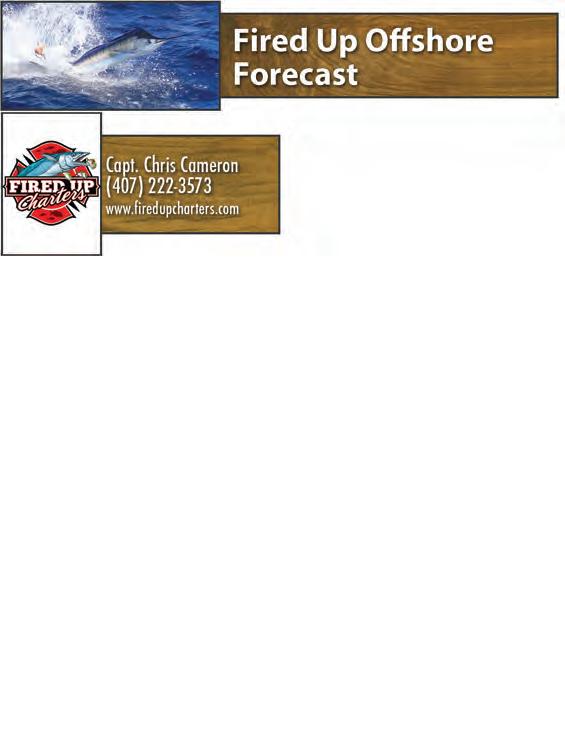
well, many fish in the 40/50lb red
Shark fishing has been on fire as well. I know many say I don’t want to deal with sharks, or you can’t eat them. You are completely wrong. On light tackle they are so much fun, and blacktips are great to eat. Ever wonder why many restaurants are out of the shark kabobs? And I assure you, there’s no shark shortage. Just take what you will eat! No waste please. We need there to be plenty of sharks and every other species for our future kids. This report has been brought to you by Captain Chris Cameron of Fired Up Fishing Charters, your premier fishing guide charter of shark fishing Cocoa Beach, offshore fishing Port Canaveral, nearshore fishing Cape Canaveral, Orlando charter fishing.
Nearshore beach fishing is going to really be picking up. Tarpons are there and rolling every day. You can slow troll them or just drift in the mornings with live bait. We have caught them on everything. Chunk baits, live baits and artificial. There is not much they won’t eat. Beach fishing in 20-30 feet is a blast. You’d be amazed how shallow all these fish come in. Kings, bonito, jack crevalle and many other extreme fighting fish. Look for the schools of bunker. If you find them, you will find the fish. Shark fishing is about as good as it gets right now. If you’re looking for some fun with the kids, anchor up in 20 feet off the beach and hold on. Bonita and king are an excellent bait for the toothy critters.
move in close. Pods of Atlantic menhaden (pogies), thread fin herring (greenies), and bay anchovies (glass minnows) will all be shadowed by predator species like large tarpon, smoker kings, blacktip and spinner sharks, jack crevalle, bonitoand redfish. Focus your attention on bait pods where there are visible predators, feeding activity and active bird feeding.
live shrimp or a piece of shrimp on
and red fishing on the flats. The grass is getting higher, so pitch into the sand holes using paddle tails or gold spoons with 20# leaders tied to 6-10# braid. Expect schools of redfish and black drum to increase in size as they have been gradually the last 2 months. For black drum, if you can see them, throw live shrimp or a piece of shrimp on a jig head and let it sit.
In the ocean, Tripletail are not as common as earlier in the year but there are still some good days on the buoys and free swimmers if we have strong southeast winds. We should start seeing the tarpon show up on the beach in late May and June. Usually when we get more bait showing up like pogies, the tarpon will show up too. Sharks are also thick this time of year around the bait and tarpon. Jack Crevalles will be mixed in with the tarpon.
As we approach the end of the month and the beginning of the fall mullet run, look for snook fishing in the surf to improve as they move into the surf break to feed. Remember snook season is closed in August, so please handle, and release them with extreme care. The snook populations in our area are elevated this year due to the warmer than usual winter we experienced.
the tarpon will show up too. Sharks around the bait and tarpon. Jack tarpon.
Troy’s tip of the month: Get out early, fish the morning hours, then it will slow down but will pick up again late morning for sight fishing if no clouds are around. Early afternoon is usually productive as well.
it will slow down but will pick up well.



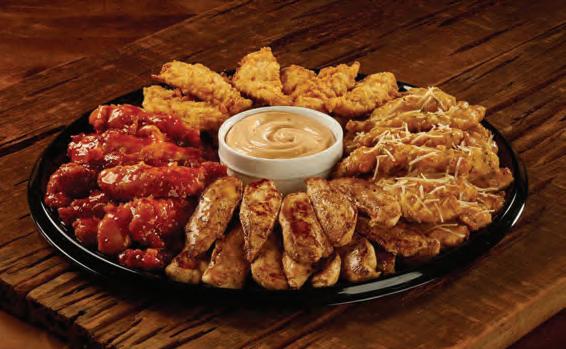
STOP BY A LOCATION NEAR YOU OR ORDER ONLINE
Altamonte Springs | Champions Gate | Dr Phillips
Lake Mary | Orlando Millenia Blvd. | Ocoee
Oveido | UCF | Weikiva-Hunt Club | Winter Springs www.hueymagoos.com

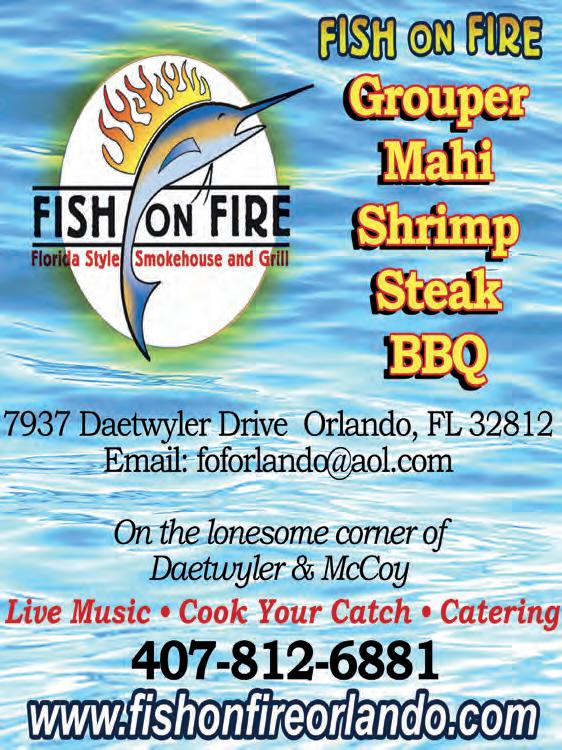
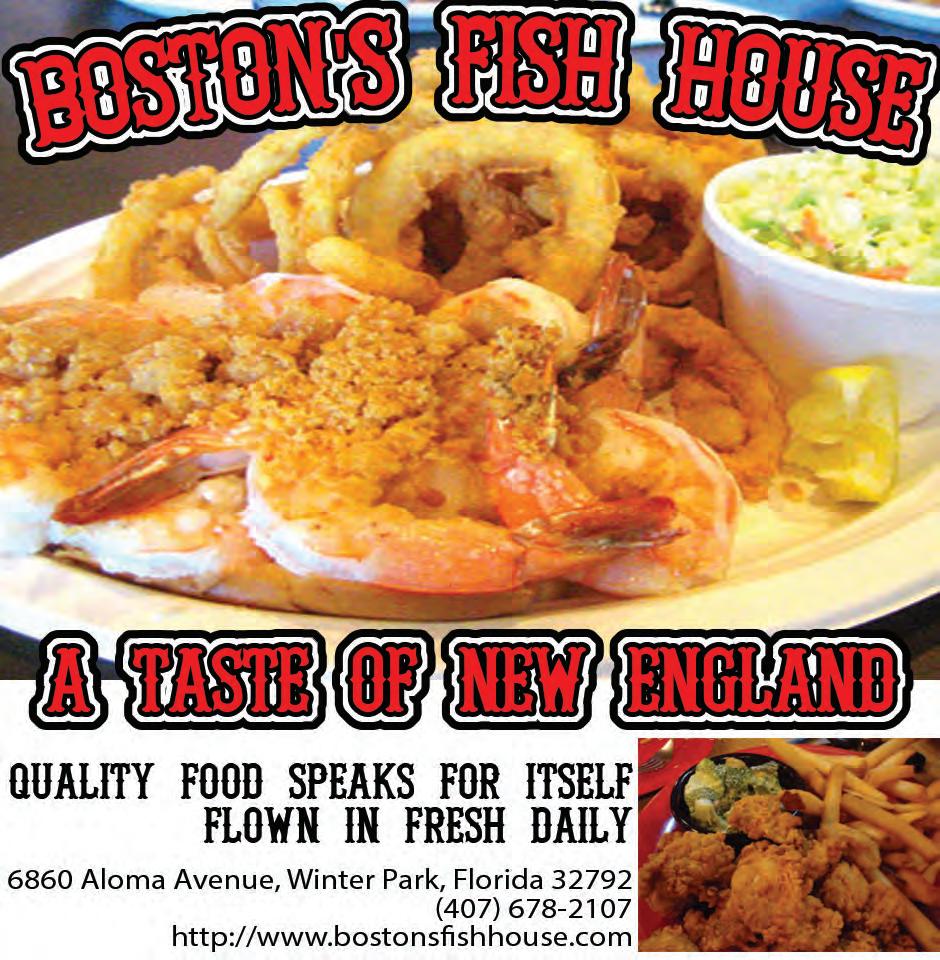
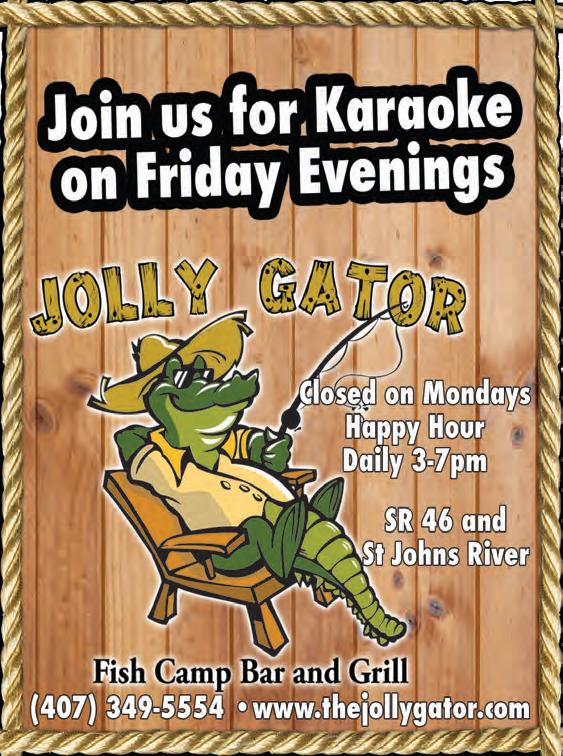



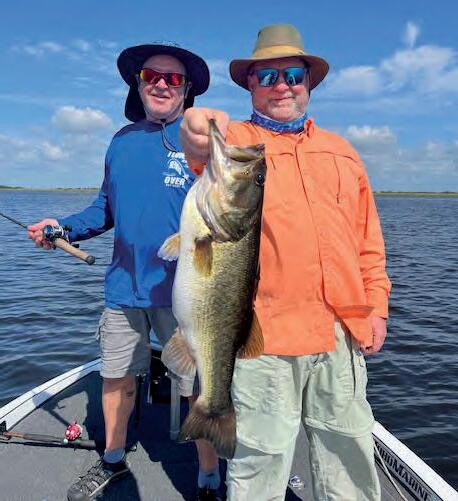
 CAM owner Phil Wolf & son Josh with just under 20 lbs. at the Toho Marine Elite Pro Team series out of Camp Mack
Quinten Farrell with “Big Bass” of the evening at Jolly gator Bass Series and another win for him!
Garrette Rockamora with “Big Bass” of the event at recent Toho Marine Bartow Ford Elite Pro Team Trail with this 10.26 monster from Lake Kissimmee
“Biggins” still biting at Lake Okeechobee fishing with Capt. Angie Douthit!
CAM owner Phil Wolf & son Josh with just under 20 lbs. at the Toho Marine Elite Pro Team series out of Camp Mack
Quinten Farrell with “Big Bass” of the evening at Jolly gator Bass Series and another win for him!
Garrette Rockamora with “Big Bass” of the event at recent Toho Marine Bartow Ford Elite Pro Team Trail with this 10.26 monster from Lake Kissimmee
“Biggins” still biting at Lake Okeechobee fishing with Capt. Angie Douthit!


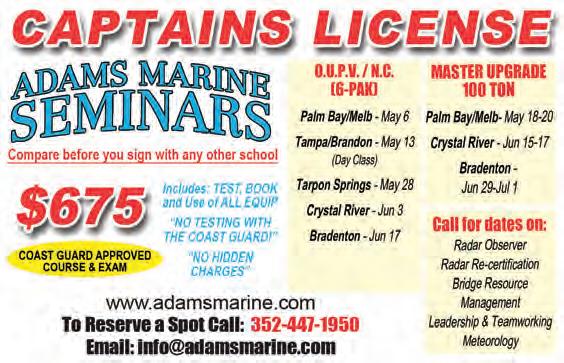


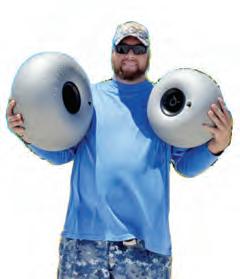

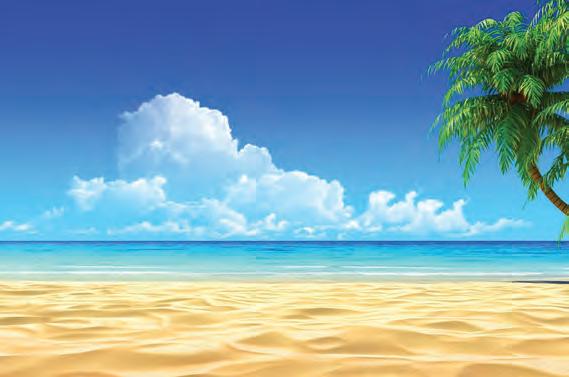




Pasco County scallopers will get a 40-day season in 2024 afer the Florida Fish and Wildlife Conservation Commission approved a change to the management region during a February meeting. Te season for the Pasco County Zone will begin July 10 and run through Aug. 18, annually.
Tese long-term season dates were informed by the 2023 post-season monitoring results by FWC’s Fish and Wildlife Research Institute as well as input received from stakeholders at virtual public workshops, in-person meetings and public comments.
“Along with moving away from the Independence Day holiday, the longer season will increase both the public’s safety and access to one of our state’s most fun family resources,” said FWC Commissioner Preston Farrier. “ Tere will be many positive impacts for the local communities.”
Te Pasco Zone bay scallop region includes all state waters between the Hernando/Pasco county line and the Anclote Key Lighthouse in northern Pinellas County, and includes all waters of the Anclote River. For complete regulations, visit MyFWC.com/Scallops.
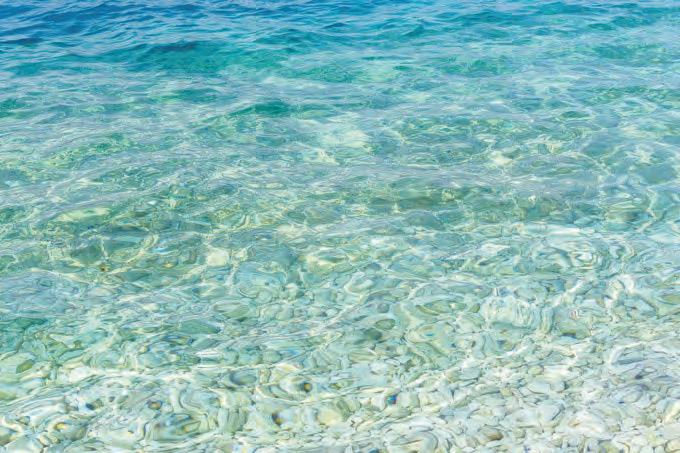




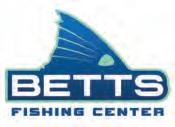


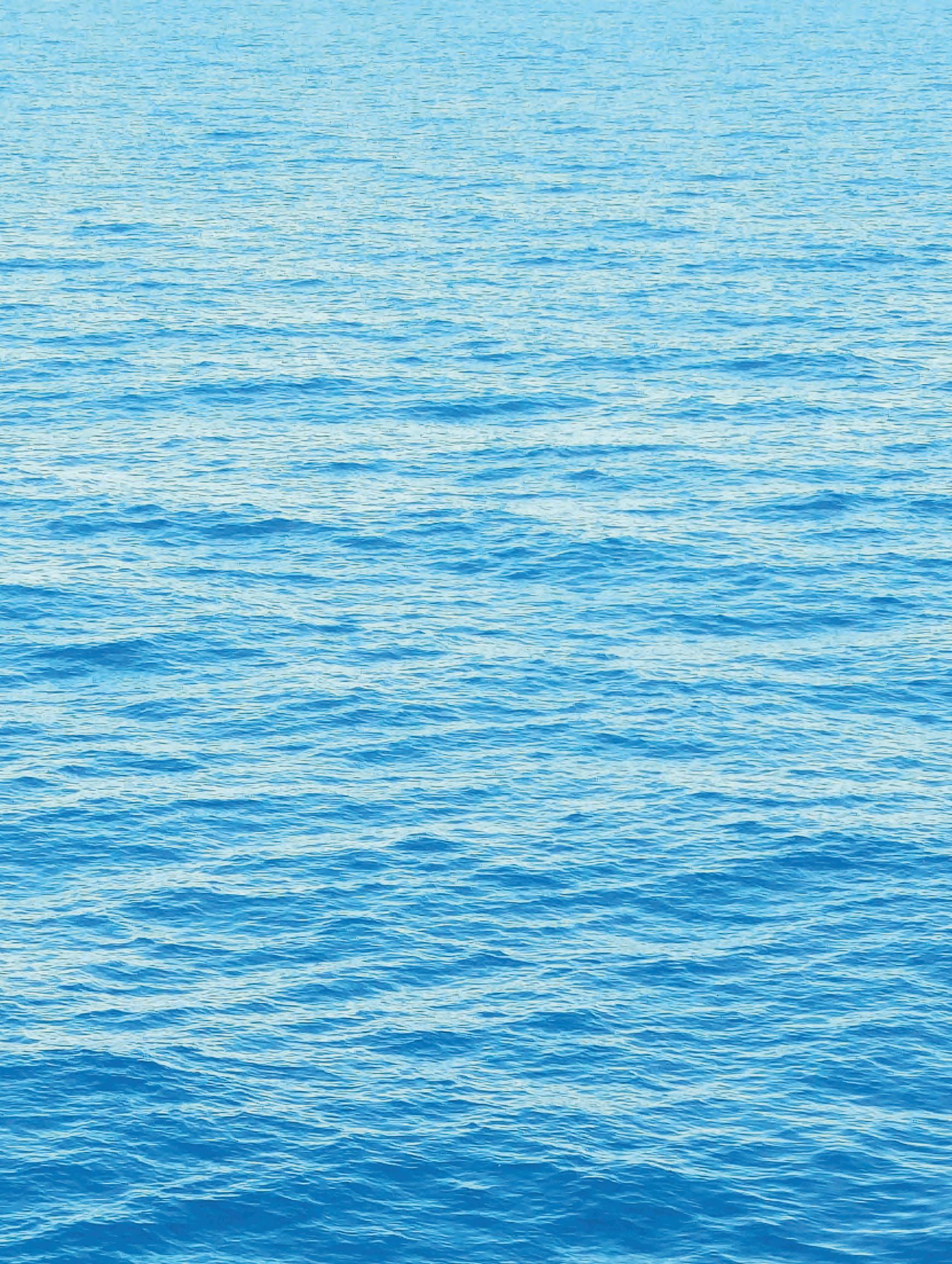

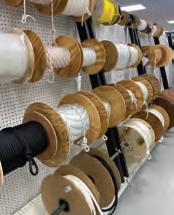
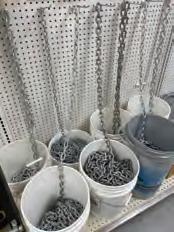


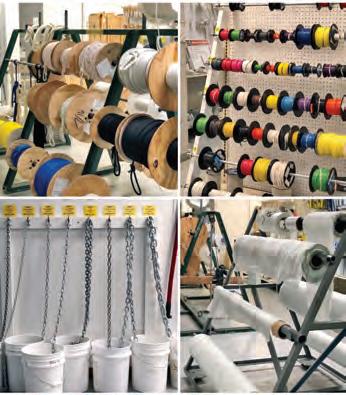
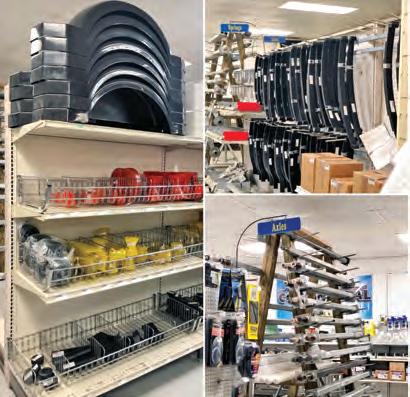




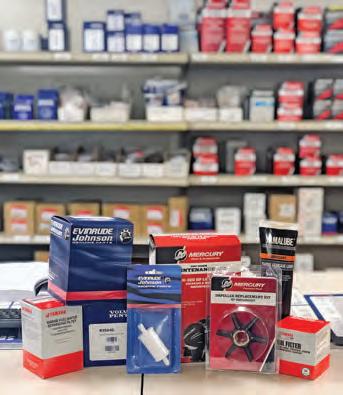








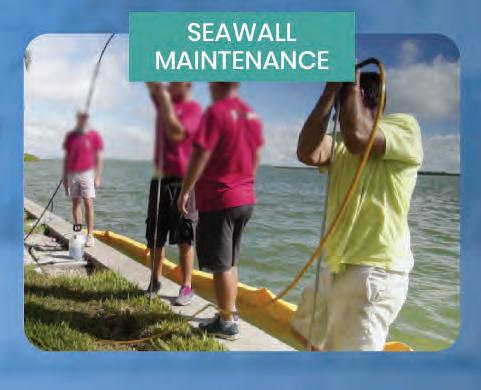





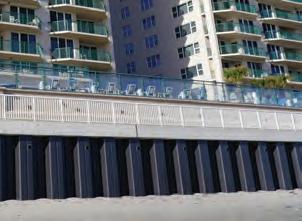
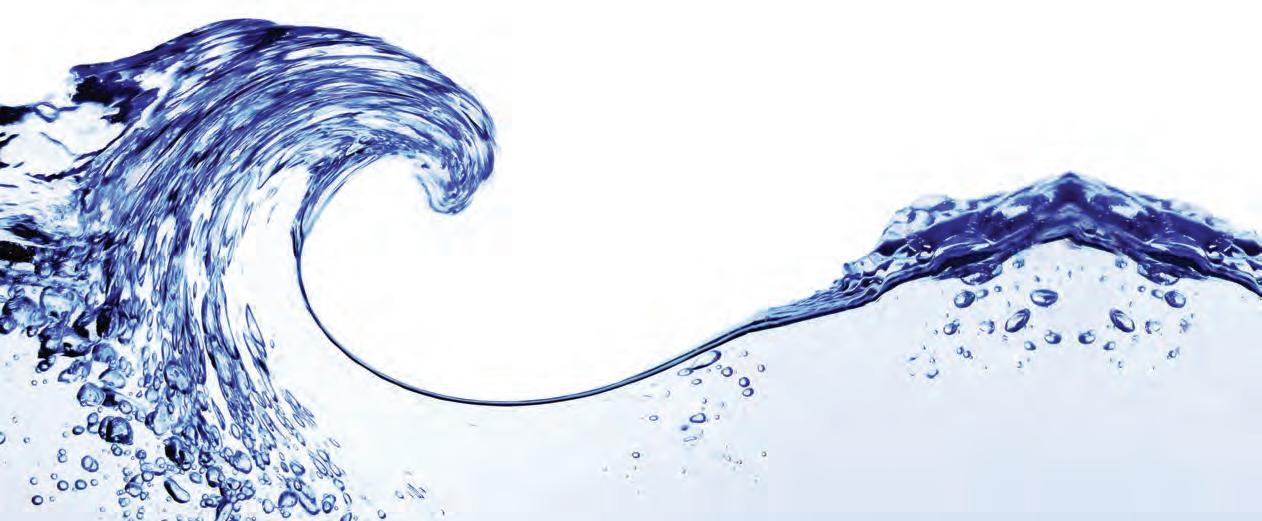
 By A. deGruchy
By A. deGruchy

You’ll fnd some real giants lurking in Florida waters, ofen hanging out near wrecks, structures and mangrove roots. Te notorious Goliath grouper is a massive, territorial and iconic Florida fsh that has experienced a remarkable comeback in recent years, prompting the Fish and Wildlife Conservation Commission (FWC) to introduce a lottery system for limited harvest.
It’s been quite the journey for these giants of the sea. Back in the 1990s, they were critically endangered, and conservation eforts swung into action


to protect them. Trough the 2000s, Goliath grouper started reappearing in South Florida’s coastal waters in greater numbers. Some saw this as a positive thing, while others focused on the negative potential impact on the marine ecosystem.
With their enormous size, reaching lengths of over 8 feet and weighing up to 800 pounds, these beasts could easily throw of the delicate balance of fsh populations and reef habitats. Despite the initial concerns, strict conservation measures and protective regulations led to a remarkable population rebound. Tey once again rule as apex predators; some would even call them bullies!
We were lucky to receive one of the tags to harvest a Goliath this year. Tere were specifc protocols to follow. Te FWC divided it into Category I and Category II, restricting the fshing areas. Additionally, there was a stipulation to use non-ofset, non-stainless steel hooks to improve survival chances. Tere was also a research element involved. We were issued a kit for taking samples and instructions on where to drop of the carcass afer our fsh was cleaned.
Goliath grouper have big appetites, eating large quantities of food to sustain their massive size. Tese underwater monsters can consume up to 5 percent of their body weight in a single feeding, so an average adult weighing around 400 pounds might eat 20 pounds. Tat’s a hefy meal by any standard. Tey also eat pretty much anything that moves, and they love crustaceans, especially stone crabs.
With our tag, we managed to catch one that fell within the slot size of 24 to 36 inches set by the lottery. We gave it a try, and to our surprise, it tasted great, like a meatier version of traditional grouper: white, faky and juicy, probably due to their diet.
Goliaths are a lesson in how tricky the balance can be between preserving our marine life and using it responsibly. From nearly disappearing to bouncing back in a big way, these amazing creatures keep us hooked on their journey. Tey remind us how everything in the ocean is connected and how important balance is. Whether we’re rallying to protect them or frying them up for dinner, Goliath grouper are a signifcant part of what makes Florida’s marine ecosystem so unique.
To see the episode of our Goliath Grouper Catch & Cook, go to “Bean Sportfshing TV” on YouTube. For more information about FWC’s Goliath Grouper harvest program, visit: www.myfwc.com.

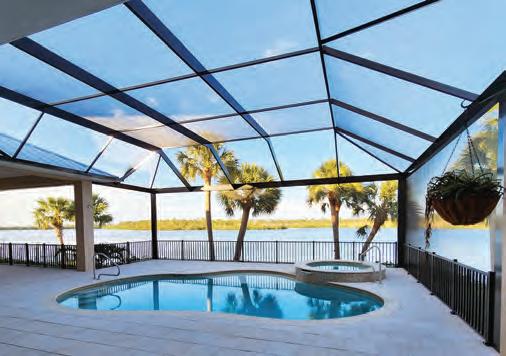
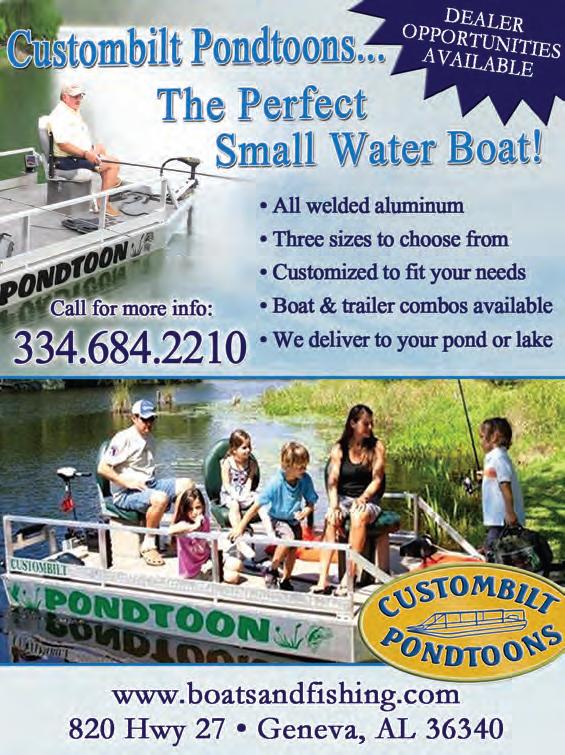
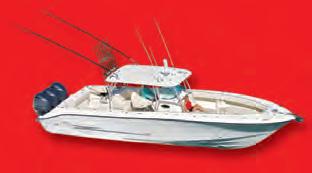


 By Emily Hanzlik
By Emily Hanzlik

Amberjacks are powerful fsh with a never-quit attitude that makes them prized among anglers who live for the battle. Tey are a widespread species, with a pretty much worldwide range and prefer depths from 60 to 250 feet. Typically, they live near reefs and shipwrecks in small schools. Tis is due to their diet being mostly smaller fsh, crustaceans and squid that live around these structures.
An amberjack might live its whole life around these structures and only move due to lack of prey or for spawning. Amberjacks broadcast spawn, but usually in smaller groups. A single female can produce anywhere between 20 and 50 million eggs. Afer spawning, these fsh participate in some sort of courting and will stay in pairs. Adults can weigh up to 200 pounds and grow to 6 feet in length with a lifespan of more than 15 years. Most angler encounters are with fsh up into the 40-pound range.
Ofshore and nearshore in appropriate depths, you’ll want to look for AJs around structure. Most depthfnders identify structure as dark red patches that jut up from the baseline of the ocean foor. Good structure will have plenty of life around it, which will be represented on the screen as yellow and green blotches of bait and baitfsh.
Once you fnd your spot, use a typical bottom rig with enough weight to keep your bait on bottom in the current. Both live and dead baits work. It’s a good idea to butterfy larger baits, which is cutting the spine and ribs out while leaving the head and skin-on flets intact. For live baits, fsh any baitfsh in the 3- to 5-inch range.
Jigging is another fun way to target these monsters. My friend Nick DeGannaro recently caught a giant AJ on a jig, and here are a few tips he provided.
“Dropping a slim-profled jigging spoon and ripping it back up towards the surface usually elicits the bite, which will stop all motion you had going as the rod doubles over and line starts disappearing of the spool,” he said. “It really is a thrilling fshery, but one you have to show up prepared for, as it will push your tackle to the limits.”
DeGannaro’s go-to outft for speed jigging is an 8000-sized reel flled with 30-lb. braid paired with an E-Fish-Ent Custom Rods Phantom Jigger 250. He fshes a 40- to 60-lb. fuorocarbon leader, depending on water clarity, and either a glow or shiny jig.
Amberjack regulations vary on the Atlantic and Gulf coasts, so check the regs before you go. While some enjoy the buttery favor of amberjack, others are turned of by the tapeworms most AJs have in their meat. Whether you plan to keep one or not, these reef bullies sure are a lot of fun to do battle with.
Emily Rose Hanzlik has caught more than 60 IGFA world records in various categories. Find her on social media @emilyhanzlikoutdoors.



 By Richard Matteson
By Richard Matteson
Surf casting is a great and inexpensive way to catch quality fsh. I’ve landed big tarpon and snook from the beach and small panfsh like whiting and croaker. You can catch dinner or experience the thrill of battling some the top sportfsh in the world.

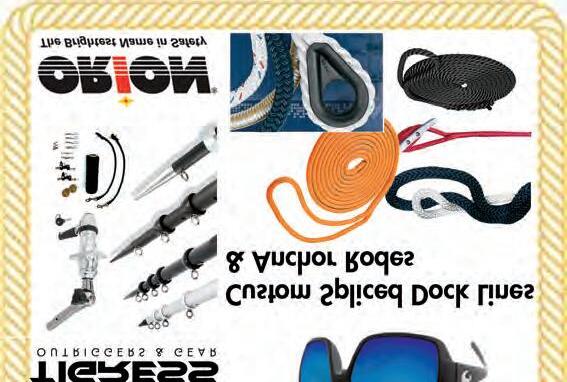
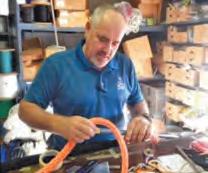

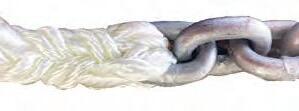


GEAR: I carry two rods, one for big fsh and one for smaller fsh, so I’ll be prepared for whatever I encounter. My lighter set-up is an 8-foot mediumaction rod with a spinning reel flled with 10- to 20-lb. braid attached to 12 inches of clear 30-lb. fuorocarbon leader.
For tarpon, big snook, sharks and big jacks, you need 40- to 60-lb. braid (200-300 yards) with a 60- to 80-lb. clear fuorocarbon leader. For big fsh, you need a heavier rod and 6000-8000 reel with a bigger spool for more line.
LURES: Tie your lures to your leaders with a loop knot. My favorite lures include 4-inch DOA paddletail (pearl white or silver sparkle) rigged on a 3/8oz. chartreuse jig head; a 1- or 2-oz. spoon (silver Krocodile or gold Johnson); topwater plugs (Skitterwalk, Zara Spook, or various chug plugs); and shallow running crankbaits. If it’s windy or rough, you might need to fsh heavier jigs or spoons.




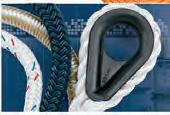
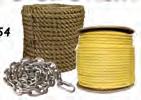
BEST TIMES TO FISH: First light and an hour before dark are the best times to fsh. Te best tides are early incoming and early outgoing. Avoid slack tides. I also use moon phases, which regulate the amount of rise and fall during each tide.
FIND THE FISH: Find the bait, and you’ll fnd the fsh. Bird activity is the most obvious sign of bait in an area. Tis could be pelicans, gulls or even small terns nipping at baitfsh. You also need to be able to spot baitfsh. Identifying the little splashes or dark mass of a school is critical.
I walk the beach looking for bait. When I see bait, I stop and fsh. Birds aren’t always there, and the bait just pops up for a few seconds and you need to be ready. Go to a beach access, get out of the car and scan for birds. If you don’t see any birds, it might be worth going to another beach access, but remember that fnding bait is sometimes just a matter of moving down the beach a hundred yards.
TECHNIQUE: Identify the feeders. Bluefsh, jacks, mackerel, ladyfsh, kingfsh and barracuda are all aggressive feeders that like fashy lures and fast retrieves. If you’re fshing for tarpon, a slow steady retrieve is better. Snook will hit a slow retrieve and can also be caught in shallower water by jigging of the bottom around the frst cut. Whiting, pompano and croakers are all easily caught twitching a lure of the bottom, but you must get it out to them.
Richard L. Matteson is a long-time contributor to Coastal Angler Magazine who reports for the Stuart Rod and Reel Club. Contact him at (336) 414-3440.

The fight for an unforgettable catch begins here, where 100,000 square miles of deep blue waters play home to speedy blue marlin and wahoo, massive tuna and brawny mahi mahi. Deep sea fishing in The Out Islands is a battle of wits, a test of perseverance, and a chance to prove your angler’s instinct. See what could be waiting on the other side of your line.


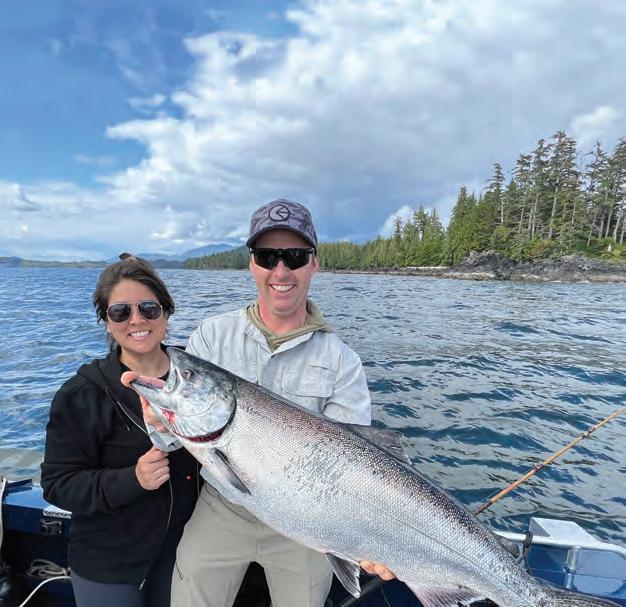
is true for human visitors, too. Te summertime fshing in Alaska can be astoundingly good.
Imagine awe-inspiring natural landscapes cascading into a sea teeming with marine life. I’ve lived and fshed in Fiji, Te Bahamas, Hawaii and Florida. Tey are all spectacular, but there’s nothing like an Alaskan summer.
My own journey to Alaska began as a young man when I dreamed of one day fshing there. Like most young adults, I strived to get good grades and work jobs to pay bills and tuition. I took the mainstream approach of university studies. Shortly afer graduation, I obtained a position with a fnancial frm. I loved the work; I hated the monotony of a nine-to-fve work life. Afer a year and a half, I called it quits and fed to Alaska with no contacts or the faintest idea of what it would be like. It’s now been 12 years, and I still call Alaska home for the summer fshing season.
I operate Ketchikan’s Finest Fishing Charters. My fshing partner, Jake Smith, and I consider ourselves lucky for the opportunity to provide topfight experiences for clients every day.
Te prime fshing season in Ketchikan is May through September, and we provide customized charters for any group, regardless of age or experience. You can expect to catch halibut, salmon, rockfsh, cod and even Dungeness crab. We ofer full-day and multi-day packages, with daily catches aggregating over hundreds of pounds. In addition, we ofer cruise ship charters for salmon and halibut to ft each visitor’s port times. With pick-up and drop-of from downtown ports, it’s the best way to fsh during an Alaskan cruise.
John Muir, the famous naturalist, wrote that you should never go to Alaska as a young man because you’ll never be satisfed with any other place as long as you live. From frst-hand experience, I believe this to be true.
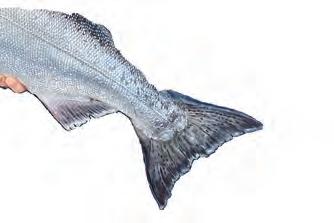
Alaska still holds riches beyond one’s wildest dreams. Hundreds of millions of salmon food into their native streams and rivers to spawn each year. Giant barn-door halibut scour the deep seas. Humpback whales migrate thousands of miles to feast on Alaska’s annual summer bounty. Eagles, bears and other wildlife abound and celebrate summer, when it’s a feast for all. Tis
Imagine riding to the richest Alaskan fshing grounds with humpback whales breaching on the horizon. Eagles soar overhead and swoop to pluck salmon from the sea. Te fshing is insane, with massive halibut and lightsout salmon fshing. It’s sensory overload in a good way, and an experience that should be at the top of everyone’s bucket list.
If planning a fshing trip in Alaska seems daunting, know that modernday Alaska is accessible to all. Tere’s no need for foat planes or dog sleds. Ketchikan is a two-hour plain ride from Seattle in a commercial airliner that touches down in a modern airport. From there, everything is at your fngertips.
Check out Ketchikan’s Finest Fishing Charters at ketchikanfshingtrips.com. Contact them (907) 617-4717 or e-mail ketchikanfshingtrips@gmail.com.



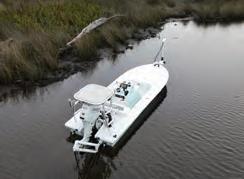
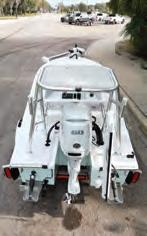
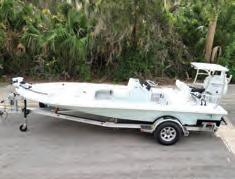




Boating is unpredictable but with a BoatU.S. Unlimited Towing Membership, it’s easy to keep your cool if something goes wrong. With more than 600+ red boats on the water, TowBoatU.S. will have your back.
Anglers

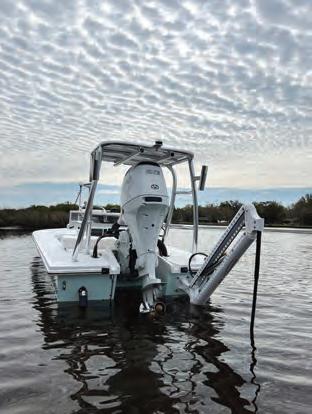
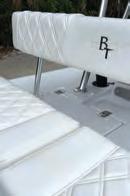

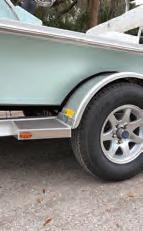



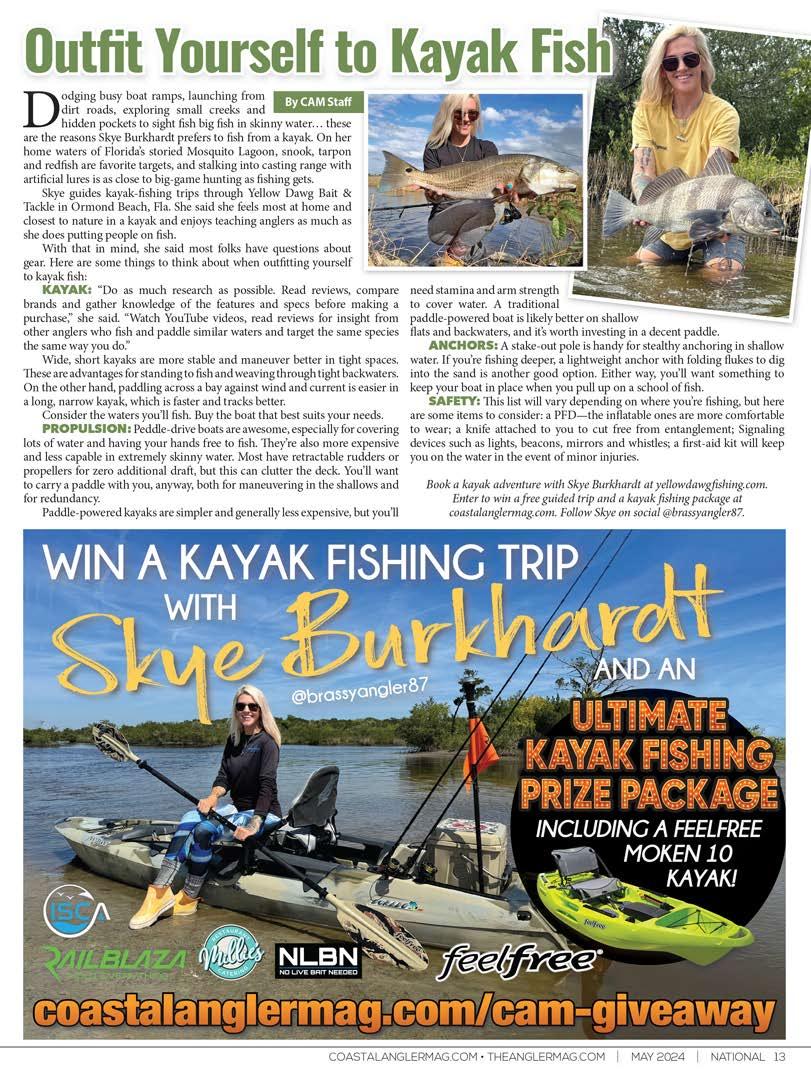
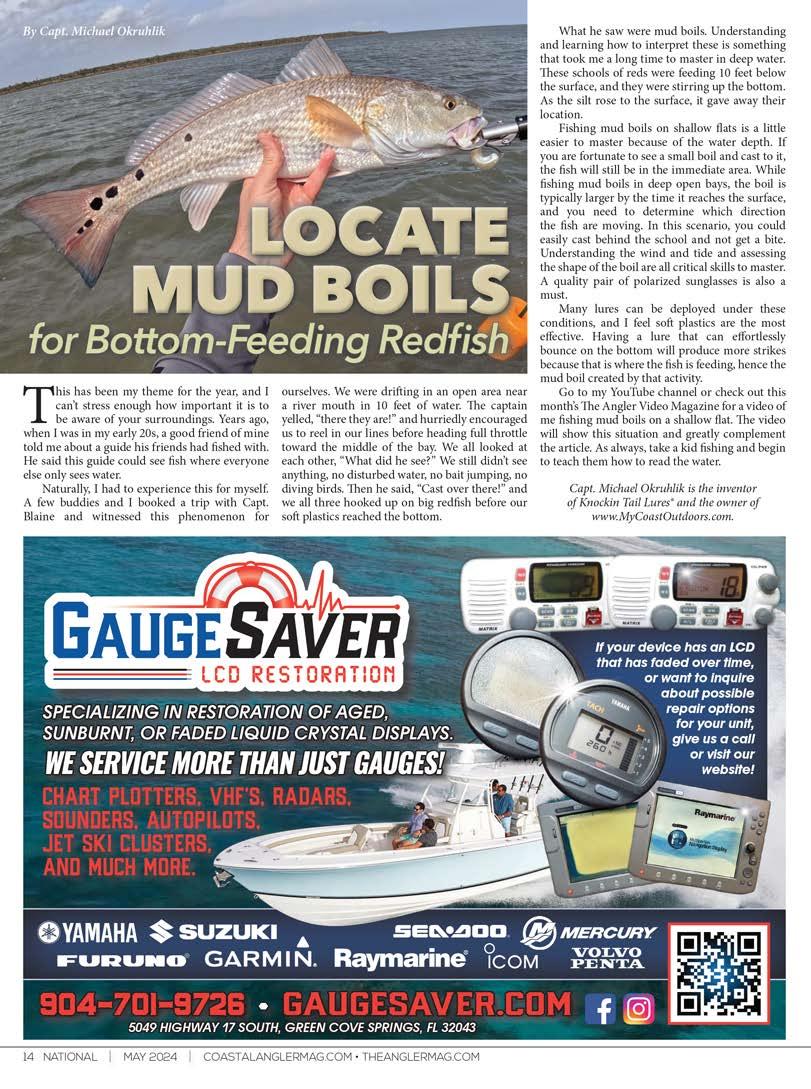
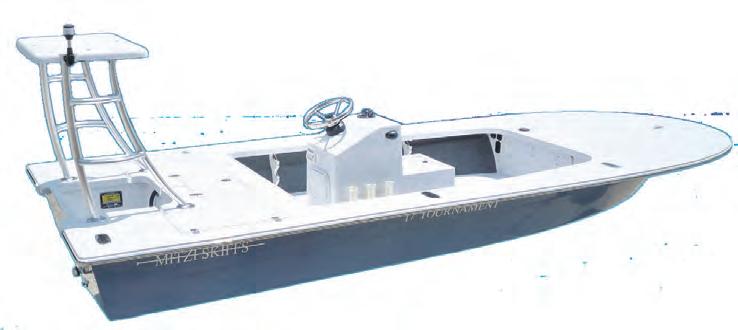
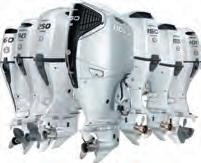
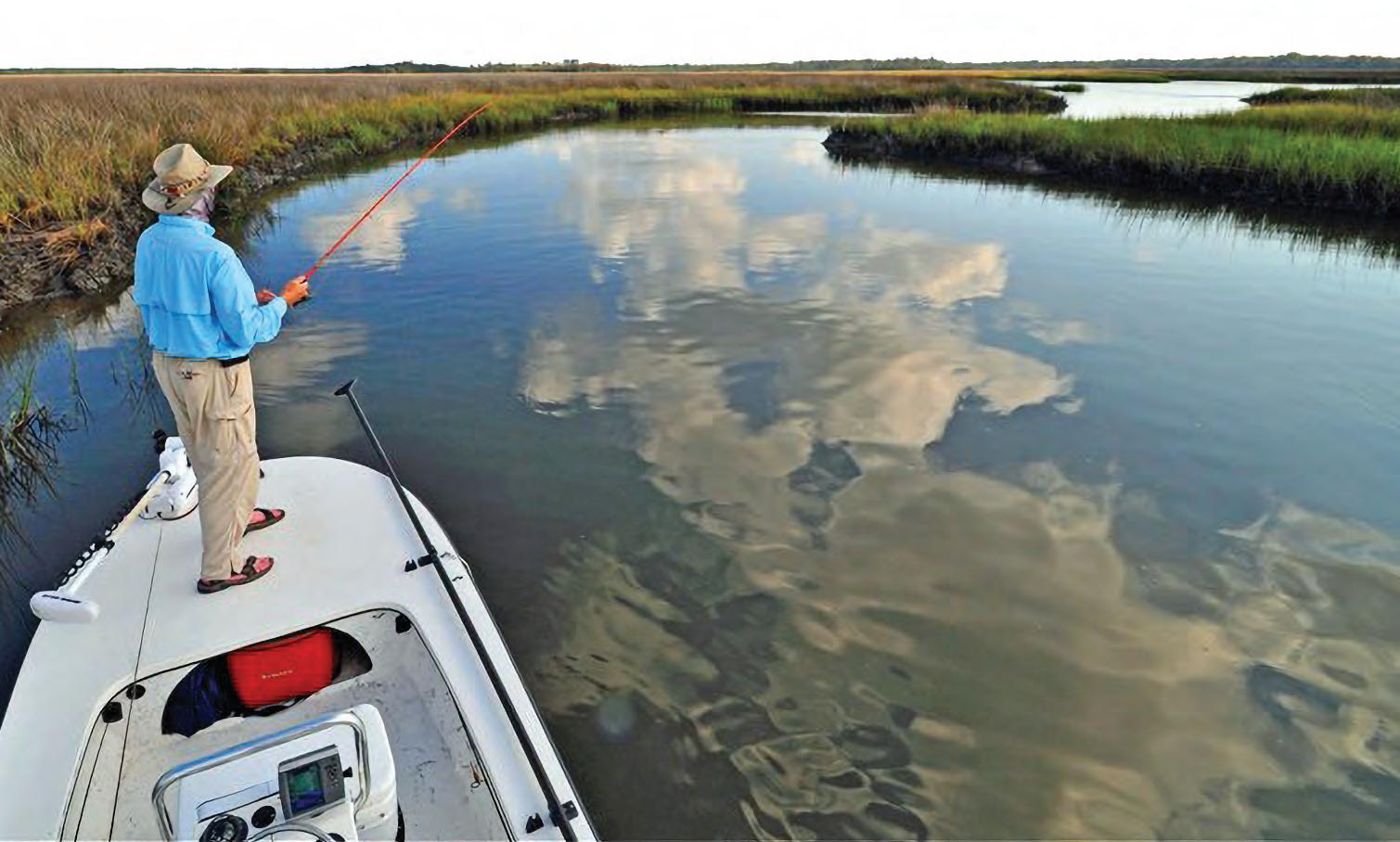
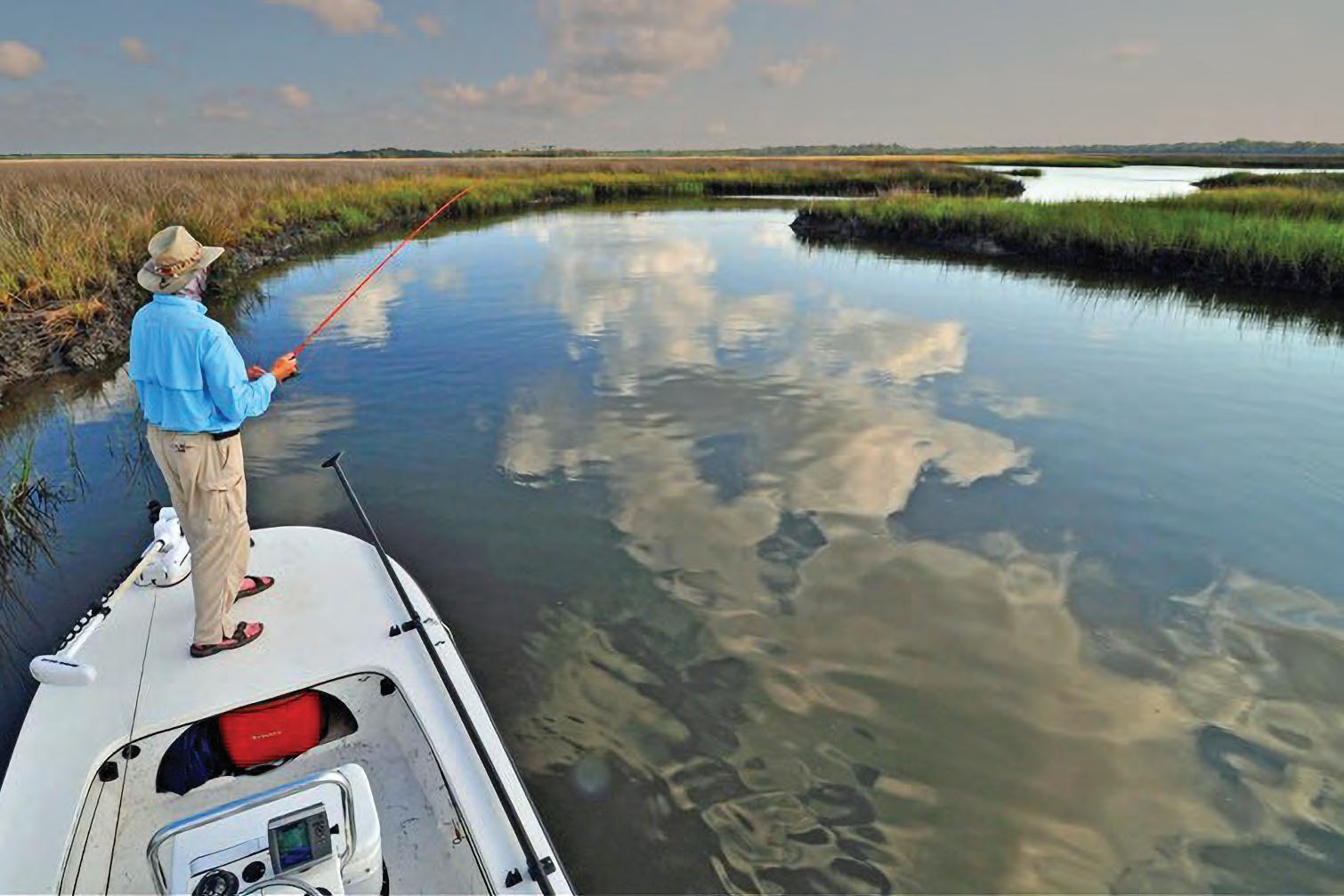
The year is 2024, and technology is getting better and better. Whether it be the retail tech business or the fshing industry, there are tools now available that a few years ago we would have never thought were even possible. One of those technologies is forward-facing sonar (FFS). Tere’s a lot of debate about FFS in the fshing these days, but there’s no denying it’s an amazing tool when used correctly.
I have been using this technology since its earliest stages, and catching fsh while looking at my screens has become one of my favorite ways to fsh. It is extremely cool to watch a fsh eat your lure in real time, and it can also teach you a tremendous amount about what is happening under the water. Not only do I use this tech to fnd and catch fsh, I use it to pinpoint bait and areas with life, fnd sweet spots and diferentiations in an area, and eliminate dead water much faster ever before.
Figuring out how to use this new technology can be a little frustrating at frst if you don’t quite understand what’s going on. Spending time on the water, doing as much research as possible or getting someone experienced to teach you are the best ways to get an upper

hand. Fishing lakes where catching fsh isn’t very hard in general helped
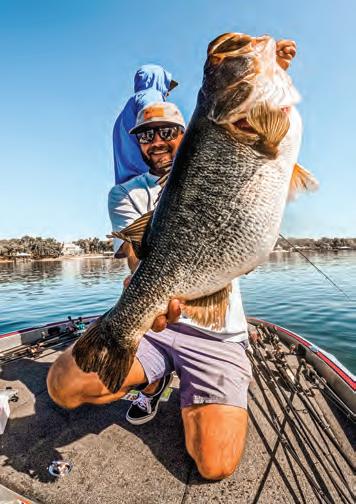
me tremendously with deciphering what I saw using FFS. Smallmouth fshing in the north country was a big helper, as these fsh are aggressive and you get many opportunities to present baits and dial in your skills.
Another thing that helps you understand the picture on your screen is objects that are visible above the water. Point your transducer at a bridge, dock, tree or grass, and picture in your head what should be under the water while also watching your screen. Tis will help beginners dial in settings and get a better understanding of what is displayed. It takes time, patience and dedication to learn, but don’t get frustrated and try to have fun with it.
Tere are varied opinions on forwardfacing sonar and its place in the fshing industry, but it isn’t going away, it will only get better! Some of the coolest things I’ve witnessed and some of my best fshing days were due to the electronics on my boat.
Spending the time to learn how to use FFS is well worth the efort. Te technology is dominating pretty much every tournament right now, and it absolutely revolutionized the way I break down a body of water.
Tere are many resources out there to help you in your learning process and people like me who are always willing to answer questions. Don’t be afraid to reach out, tight lines!
Tyler Woolcott is a professional tournament angler and guide. Check out his website at www.tylerwoolcottfshing.com.
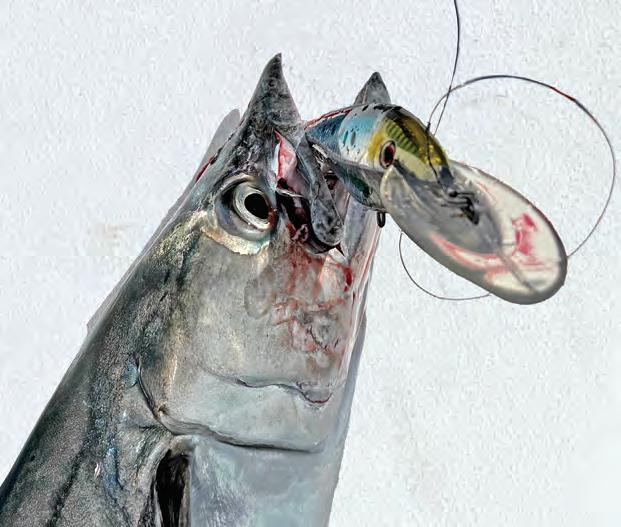
It’s well known that some of the best kingfsh fshing starts with a livewell full of frisky baits. Unfortunately, catching them can eat up much of your fshing time. Afer that, it can be hours of bump trolling waiting for a fsh to hit. Fortunately, for those who just want to head out for a couple hours of fun and blistering runs, it can be accomplished with artifcials. Besides getting you straight to the fshing, you can cover a lot more ground by pulling hardware, and it is not nearly as tedious.
Like using live bait, wire leader is crucial. Kingfsh have razor sharp teeth that will go through even stout mono with little efort. I prefer single-strand wire and usually opt for at least #7 (80-lb.). Single strand tends to kink afer just one fsh, but that’s not always a problem when pulling big plugs, as they will pull the wire straight. Also, watch your split rings. Tey can weaken the loop where it attaches to the lure, so be sure to constantly inspect your connections. I like to cover many diferent depths in the water column when trolling. I

start with a shallow runner like the Nomad 190 AT that runs 3 to 5 feet deep, which I set way back. I also like the Nomad Madmacs that run just slightly deeper. I run it 30 to 50 feet in front of my shallow long-bait to facilitate turning. Ten I like to go deeper with a DTX Minnow 165. I run that close to the boat and right under the prop wash. Tis is hands down my most productive bait. I fnd speeds of 6 to 8 knots usually work well. Tis allows me to cover a lot of ground and is fast enough to elicit a strike. I ofen fnd any slower and the fsh don’t seem interested. Te other great thing about these lures is the hooks are very large, and they stick once they make contact.
When you’re trolling the deeper-diving DTX 165s, you will need a reel with some signifcant drag, as these big-lipped plugs take a lot to hold in place. Te Accurate BV600, with its dual drag system, is a great reel for the job. Te BV X76H matches perfectly with it and is a great multi-duty trolling rig that doubles as an awesome grouper rod. Even though you don’t need a super-light tip, like with live bait, a rod that gives is a plus with these sof-mouthed fsh.
As for spots, look for hard bottom that holds bait. Wrecks and reefs are great, too. It sometimes pays to make wider circles around these structures to get away from the barracudas.
With a few lures and some know-how, you can easily head out and catch some kings without dedicating an entire day to your eforts.
Will Schmidt is a seasoned tournament anglers who has been writing about fshing for more than three decades.

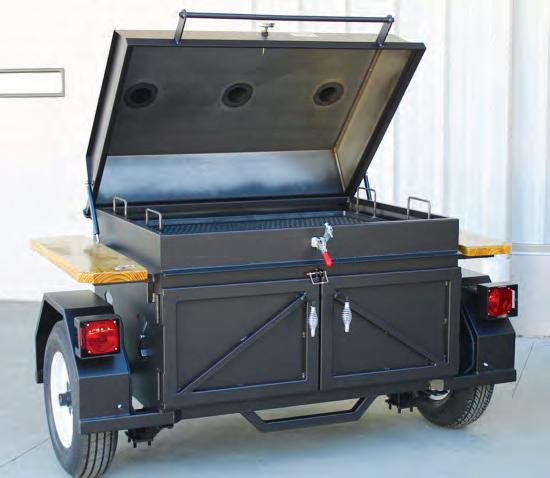
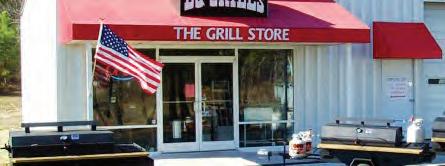
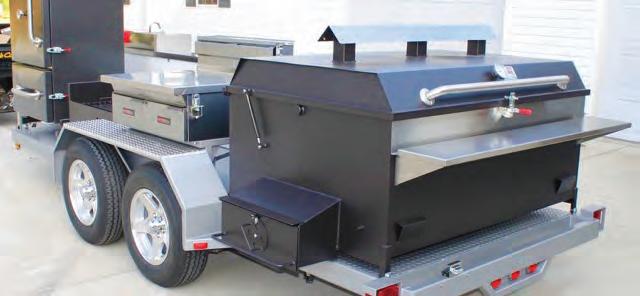




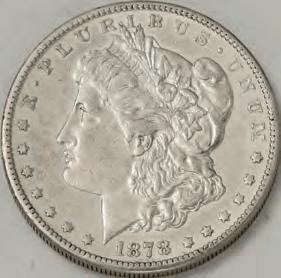


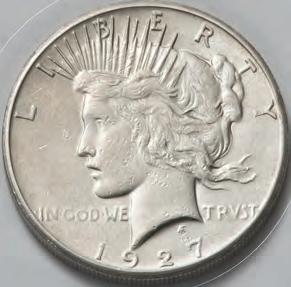














The heritage of American Silver Dollars is rich and diverse, marked by stunningly beautiful designs, leading to an enduring desirability in the hearts of collectors around the world. In this iconic U.S. Silver Dollar set, spanning nearly 150 years, you’re getting FIVE American Silver Dollars issued over the last 15 decades that each reflect the history, culture and economic aspects of the United States.
Each of these U.S. Silver Dollars is sought-after by collectors individually, but this set includes every design of U.S. Silver Dollar in American history, issued from 1878 to 2024!
Morgan Silver Dollar: First struck 146 years ago in 1878, the Morgan has a historic legacy as the coin that helped build the American West. Minted until 1904, then again in 1921, this 90% silver coin with its iconic Lady Liberty design is the most collected vintage Silver Dollar in the world. Extremely Fine (XF) condition coin included in set.
Peace Silver Dollar: With a beautiful design memorializing peace following the end of World War I, the 90% silver Peace Dollar was intended as a one-year only release struck in 1921—but it proved so popular with the American people, it was struck until 1928, then again in 1934-35. Extremely Fine (XF) condition coin included in set.

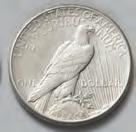
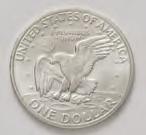



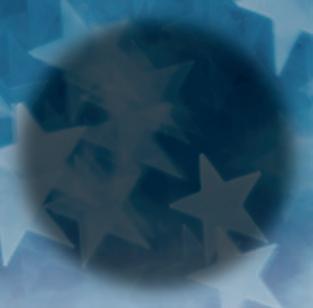

Eisenhower Dollar: The last circulating U.S. dollar coin, the Eisenhower Dollar, aka the “Ike Dollar,” was prized by Americans, with its design featuring war hero President Dwight D. Eisenhower, backed by an image symbolizing the Apollo II moon landing. First struck with silver 1971-1976, the Eisenhower Dollar in this set was struck in 40% silver for collectors, and you will receive a coin in Brilliant Uncirculated (BU) condition.



















Silver Eagle Type 1: The first-ever U.S. Silver Dollar minted in 99.9% silver, these coins were first minted in 1986 following President Ronald Reagan’s signing of the Liberty Coin Act into law on July 9, 1985, which authorized the U.S. Mint to strike America’s new silver bullion coin. This gorgeous Silver Dollar features the original, revered Type 1 “Heraldic Eagle” reverse design by John Mercanti, 12th Chief Engraver of the U.S. Mint. Brilliant Uncirculated (BU) condition coin included in set.
Silver Eagle Type 2: In honor of the popular 99.9% silver coin’s 35th anniversary in 2021, the Silver Eagle received a new, esteemed Type 2 “Eagle Landing” reverse design. This is the current issued coin by the U.S. Mint. Brilliant Uncirculated (BU) condition coin included in set.
SAVE with this Ultimate U.S. Silver Dollar Set! You’ll save both time and money on this 150 Year U.S. Silver Dollar Set, with FREE SHIPPING and a BONUS presentation case, plus a new and informative 150 Years U.S. Silver Dollars booklet! Call right now to get yours before they’re gone!



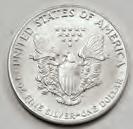






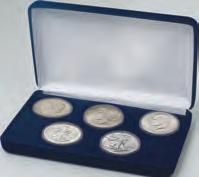

Ultimate U.S. Silver Dollars Set — Regular Price $249 - $199
Save $50.00 (over 20%) + FREE SHIPPING For fastest service call
